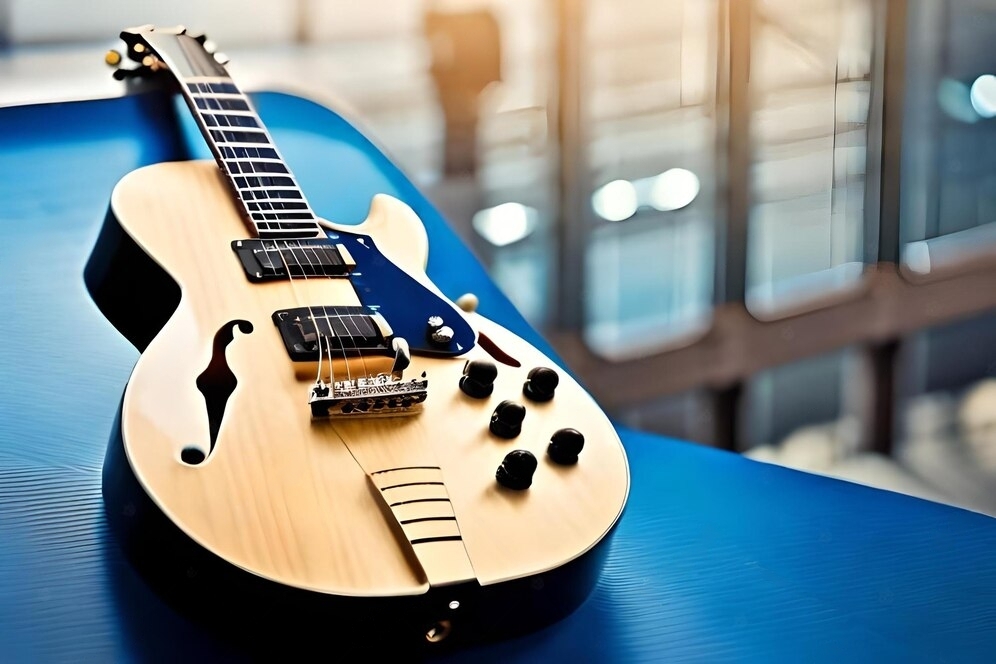Imagine the thrill of holding a piece of music history in your hands, feeling the echo of legendary tunes as you strum the strings.
That’s precisely the magic encased in every Gibson guitar, making them more than just musical instruments but treasured artifacts.
This blog dives into the heart of Gibson’s illustrious legacy, listing the crème de la crème of Gibson guitars that have not only defined generations of music but have become the companions of legends.
Whether you’re a professional musician, an avid collector, or someone looking for a quality guitar, knowing about the best Gibson guitars of all time is beneficial.
It’s like having a roadmap to excellence, ensuring you’re well-informed before purchasing or enriching your knowledge about iconic music gear.
This article will unravel the unique features, histories, and indelible marks these Gibson marvels have left in the music world.
From the groundbreaking Les Paul Standard to the elegant Gibson SG, we’ll explore these masterpieces that have etched their names into the annals of music history.
Your journey through the highs and lows of strings will get melodious and memorable!
Table of Contents
- Best Gibson Guitars Of All Time
- Gibson SG Standard Electric Guitar
- Gibson Les Paul Studio Electric Guitar
- Gibson Les Paul Standard ’60s Electric Guitar
- Gibson Custom 1959 Les Paul Standard Reissue Electric Guitar
- Gibson Dave Mustaine Flying V EXP Electric Guitar
- Gibson Les Paul Traditional Pro II ’50s Electric Guitar
- Gibson Dove Original Acoustic-Electric Guitar
- Gibson ’70s Flying V Electric Guitar
- Gibson J-45 Standard Acoustic-Electric Guitar
- Gibson SG Modern Electric Guitar
- Gibson Les Paul Junior Electric Guitar
- Gibson ES-339 Electric Guitar
- Gibson Custom Firebird Electric Guitar
- Gibson SJ-200 Acoustic-Electric Guitar
- Gibson Custom Explorer Electric Guitar
- Gibson Les Paul Tribute Electric Guitar
- Gibson Custom ES-335 Electric Guitar
- What to Look for When Buying a Gibson Guitar?
- What Makes Gibson Guitars Stand Out?
- How to Identify a Genuine Gibson Guitar?
- What Are Some Tips for Maintaining a Gibson Guitar?
- How Do Gibson Guitars Compare to Other Brands?
- Where Are Gibson Guitars Manufactured?
Best Gibson Guitars Of All Time
Before I begin, here are my top selected choices:
|
|
Gibson J-45 Standard Acoustic-Electric Guitar

A great choice for gigging performers or singer-songwriters. Check Price
|
Gibson Les Paul Tribute Electric Guitar

Legendary Hardware Anchors.
Check Price
|
Gibson SG Standard Electric Guitar
Iconic tone with a legendary silhouette.
Boasts an iconic humbucker tone with remarkable sustain, thanks to its solid mahogany body and Alnico II pickups. The bound rosewood fretboard and rounded-profile mahogany neck promise effortless shredding and comfortable playability. Its distinctive double-cutaway design paired with premium appointments make a bold visual statement on any stage.
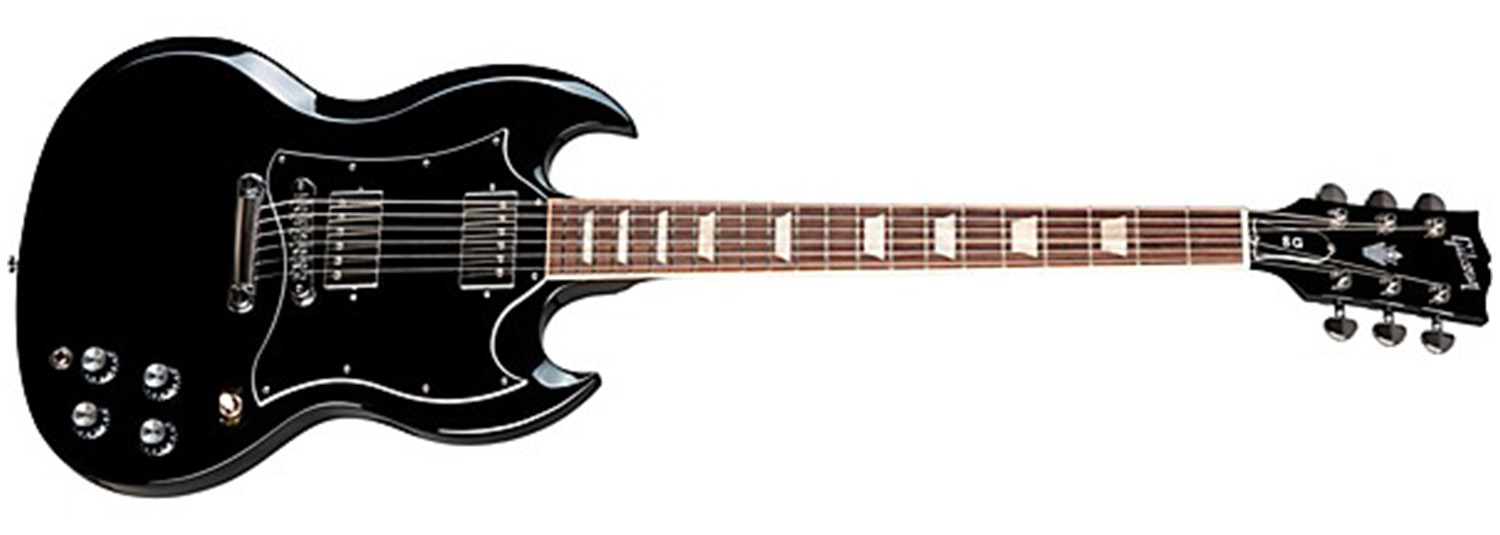
With a lineage of crafting musical marvels for over a century, Gibson brings forward the SG Standard Electric Guitar in a stunning Ebony finish.
This model resonates with a rock legend’s spirit, showcasing a solid mahogany body coupled with a rounded-profile mahogany neck, ensuring that classic humbucker sound with enduring sustain.
Loaded with the 490R and 490T Alnico II pickups, it’s built to propel your amp to new sonic landscapes.
A major highlight is the bound rosewood fretboard, meticulously Plek’d for flawless fretwork, making lightning-fast solos and intricate chord shapes an absolute breeze.
With a 1.695″-wide nut and a 24.75″ scale length, the strings find enough room to vibrate freely, producing that rich, clear Gibson tone.
Although lighter than a carved maple top, its body holds a promise of superior tonal quality.
Its visual allure is undeniable, marked by a distinctive double-cutaway body and full-face pickguard, enriched with black top hat knobs, chrome-plated hardware, and pearloid dot inlays.
With a soft shell case, the practical side also shines through, allowing you to take your show on the road confidently.
This guitar is not just a musical instrument but a statement of style and tradition intertwined.
- My Review
Upon entering the realm of electric guitars, the allure of the Gibson SG Standard in Ebony is hard to overlook.
It’s like holding a part of rock ‘n’ roll history, embodying a legacy shaping music for over 100 years.
Right from the get-go, the solid mahogany body and rounded-profile mahogany neck offer a gateway to that iconic humbucker tone with a singing sustain characteristic of Gibson.
Cradling it in my hands, the first strum resonates with a clarity and warmth that is hard to come by.
The 490R and 490T Alnico II pickups are not just pickups; they’re powerhouses that drive the amp to new heights, delivering a perfect blend of warmth, clarity, and articulation.
Whether clean or distorted, the sound is something to marvel at, leaving a lasting impression on the ears.
Now, moving on to the playability, the bound rosewood fretboard is nothing short of a dream.
It’s Plek’d for flawless fretwork, allowing for a lightning-fast action on the frets.
Soloing on this fretboard is not just easy; it’s thrilling.
The neck feels comfortable, even during extended play, and the medium jumbo frets are a perfect size, making chord transitions smooth.
Visually, this guitar is a showstopper with its distinctive double-cutaway body, full-face pickguard, and the premium touches of black top hat knobs alongside chrome-plated hardware.
It’s not just a guitar; it’s a bold statement.
However, it’s not all sunshine and rainbows.
Upon closer inspection, some finish flaws become apparent, and a rough fret was a bit of a letdown, given Gibson’s reputation.
Despite this, the SG Standard stands tall with its combination of iconic tone, exceptional playability, and timeless design.
The soft shell case is a nice addition, ensuring the guitar stays protected during travels.
The Gibson SG Standard isn’t just a guitar; it’s a companion for the rockstar in everyone.
- Pros:
- Iconic humbucker tone with singing sustain.
- Exceptional playability with bound rosewood fretboard.
- Distinctive, visually stunning double-cutaway design.
- Cons:
- Finish flaws noted upon close inspection.
- Rough fret was a slight letdown.
- Pricey for newcomers or budget-conscious musicians.
My final verdict is that the Gibson SG Standard Electric Guitar in Ebony is a treasure for any musician seeking a blend of historical legacy, iconic sound, and modern playability.
Despite a few cosmetic imperfections, its exceptional tonal quality, comfortable fretboard, and timeless design more than justify the investment.
This guitar is not only a tool but a companion for musical exploration, capable of living up to the demands of seasoned players and enthusiastic beginners willing to dive seriously into the world of electric guitars.
With the SG Standard, you’re not just playing a guitar; you’re playing a part of music’s rich history.
Gibson Les Paul Studio Electric Guitar
Unmatched sound and playability with tonal versatility..
This electric guitar combines vintage sound with modern playability, featuring a mahogany body and set neck for resonance and sustain. The slim taper neck and rosewood fingerboard offer versatile tones with push-pull pots for coil-tapping. A well-crafted instrument with top-notch features, suitable for both intricate solos and complex chords.
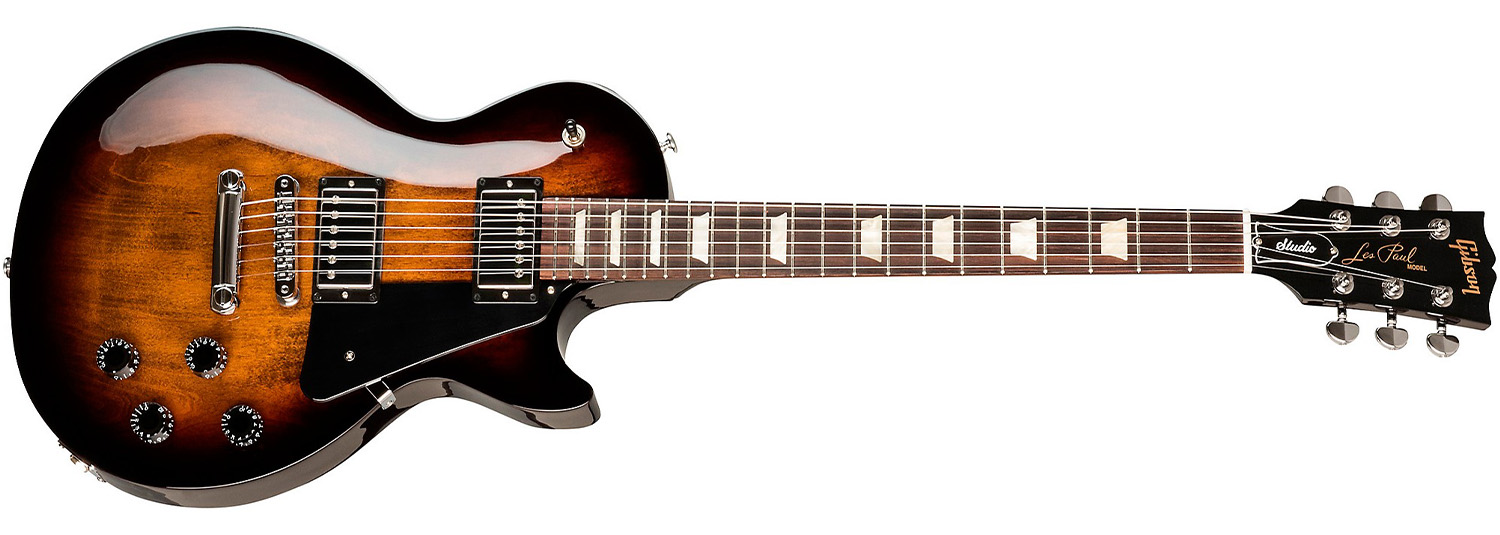
Are you after a fine blend of a classic design with updated functionality in an electric guitar?
This model might just be your pick!
Its body and neck are made of mahogany, creating a grand platform for resonance and a spectacular sustain.
Pairing a Slim Taper neck with a rosewood fingerboard provides a familiar yet swift feel, whether you’re picking out intricate solos or strumming complex chords.
Musicians can enjoy the brawny, iconic Les Paul tone thanks to the 490R and 498T humbucking pickups.
For those craving tonal versatility, it also features push-pull pots, which enable coil-tapping.
This means you’re not just stuck with the full-bodied humbucker tone.
You can also snag those zingy, single-coil tones.
Whether you want a mild jazz tone or a loud rock tone, this guitar has got you covered.
It really is a sonic chameleon!
- My Review
One of the first things that caught my attention when I picked up this guitar was its build quality.
It’s undeniably robust, with a mahogany body and neck that feel solid and contribute to an impressive sound quality.
I fired it up through an amplifier and was immediately struck by its crisp sound and vast tonal range.
Credit is definitely due to the 490R and 498T humbucking pickups, which deliver a high-output tone.
Where this model shines is its capacity for tonal versatility.
There is an easy-to-use push-pull coil-tapping feature.
That was a pleasant surprise, allowing me to easily switch between the robust humbucker tones and more nuanced single-coil tones.
Whether I’m setting the mood with a soft jazz tune or tearing it up with a gritty rock riff, this guitar doesn’t miss a beat.
However, it wasn’t all singing praises.
I did encounter a few hiccups along the way.
For starters, the finish seemed a bit fragile.
A little more effort in the finishing department would go a long way.
Furthermore, the action was a bit high for my liking initially, and I had trouble with buzz on some frets.
Despite that, I immediately knew this was a thoughtfully designed guitar.
The slim taper neck blended with the rosewood fingerboard made it aesthetically pleasing and gave it swift and smooth playability.
This model doesn’t compromise on offering the traditional vibes we know and loves from Les Paul while introducing admirable modern sophistication.
So yes, it does have a few quirks, but they are minor in light of its remarkable qualities.
It’s a solid investment for any serious player looking for an unmatched playing experience.
- Pros:
- Exceptional sound and tonal flexibility.
- Quality build with mahogany body and neck.
- Slim taper neck and rosewood fingerboard.
- Cons:
- Fragile finish prone to dents.
- High initial action.
- Some frets prone to buzzing.
My final verdict is that the Gibson Les Paul Studio Electric Guitar, despite some minor setbacks, is still a brilliant choice for any musician looking for quality, versatility, and the iconic Les Paul sound.
The playability, tonal range, and overall craftmanship make it a worthwhile investment.
While it could do with a sturdier finish and a more fine-tuned fret setup, its sonic offerings and appealing design outweigh these small concerns.
Gibson Les Paul Standard ’60s Electric Guitar
Classic design with superior tonal quality and craftsmanship
This vintage-style guitar combines a solid mahogany body with an AA figured maple top for authentic resonance. The Gibson Les Paul 60’s Bourbon Burst boasts a slim taper 60’s-style mahogany neck, hand-wired electronics and Burstbucker 61R and 61T pickups loaded with AlNiCo V magnets. Alongside its classic-style Tune-O-Matic bridge, you’ll find reliable Grover Rotomatic “Kidney” tuners and a hardshell case included.

One look at the Gibson Les Paul Standard ’60s Electric Guitar – Bourbon Burst, and it’s evident that it’s a reincarnation of the iconic classic design that has influenced generations of music.
With a nod to Gibson’s golden age of innovation, the guitar embodies unparalleled authenticity.
The guitar boasts a solid mahogany body, giving it an unmistakable resonance and topped off with an eye-catching AA figured maple.
The neck is crafted from mahogany as well, featuring the slim taper 60’s-style design, and it is adorned with a rosewood fingerboard.
The fingerboard also features trapezoid inlays, a detail that enhances the visual appeal.
Key hardware components of this guitar include a classic-style Tune-O-Matic bridge, an aluminum stop bar tailpiece, Grover Rotomatic “Kidney” tuners, and gold top hat knobs with silver reflectors.
Equipped with the Burstbucker 61R (neck) and Burstbucker 61T (bridge) pickups, this guitar uses AlNiCo V magnets, audio taper potentiometers, and orange drop capacitors.
The body is protected with a Gloss Nitrocellulose finish, and it’s made for right-handed musicians.
The neck carries a ’50s rounded shape and is set-in, with a standard truss rod and a rosewood fingerboard that has a 12-inch radius.
The guitar also features medium jumbo frets and a wide nut width of 1.69 inches, made from GraphTech.
Controls include volume 1 and 2, tone 1 and 2, with a 3-way pickup switch.
The hardware is nickel-colored, and the guitar is accompanied by a hardshell case, ensuring its safety during transit or storage.
All components of this electric guitar were meticulously assembled in the United States, maintaining high-quality craftsmanship throughout.
- My Review
As soon as I held the Gibson Les Paul Standard ’60s Electric Guitar in Bourbon Burst, its rich history and craftsmanship became apparent.
This guitar, with its solid mahogany body and AA figured maple top, and right-handed gloss Nitrocellulose finish, conveys a sense of strength and durability.
Flipping it over reveals the meticulously crafted ’60s style mahogany neck, slim in contour and made comfortable for long playing sessions by a trapezoid-inlaid rosewood fingerboard.
The presence of Grover Rotomatic “Kidney” tuners infuses it with a certain classic charm.
However, the visual aesthetics of this Gibson Les Paul Standard bear no weight without sound.
The sound quality of this guitar, undeniably, separates it from others.
Even unplugged, the resonate tones and rich harmonics might leave you spellbound, courtesy of its solid-wood body.
Notice how the Burstbucker 61R (neck) and Burstbucker 61T (bridge) pickups with AlNiCo V magnets add a vivacious touch to the tonal spectrum of this stringed instrument.
The audio taper potentiometers give you a smooth, predictable response when adjusting your tones or volumes.
Meanwhile, the orange drop capacitors assist in shaping the sound just as you desire.
This magnificent specimen is not just melodically perfect, but it also offers sheer ease in terms of handling and customization.
Be it setting the string action, tuning the guitar, or maintaining the intonation, everything seems effortless, as the guitar features a classic-style Tune-O-Matic bridge and an aluminum stop bar tailpiece.
For those professionally involved in music or serious learners, there is definitely a steeper learning curve.
However, due to the design considerations, the accessibility to upper frets is simply smooth which makes even complex musical pieces that require you to tread the topmost frets, doable and easier.
Finally, unpacking the guitar was a thrill in itself, as it comes secured in a hardshell case for safe delivery and for secure long-term storage as well.
The Gibson Les Paul Standard ’60s Electric Guitar – Bourbon Burst combines a vintage allure with dynamic sound and modern-day accents and is crafted to perfection right in the United States.
But remember, like all things beautiful and powerful, this guitar requires proper care and passion to reap its endless benefits and to truly appreciate its charismatic persona.
- Pros:
- Outstanding tonal brilliance and power.
- Exceptional design and build quality.
- Hand-wired electronics enhance performance.
- Cons:
- May be heavy for some users.
- Premium price point.
My final verdict is that the Gibson Les Paul Standard ’60s Electric Guitar brings vintage aesthetic and authentic sound back to life.
This guitar pays tribute to Gibson’s Golden Era, staying true to the classic design, and enriching it with modern enhancements.
The quality of materials, such as the solid mahogany body and AA figured maple top, combined with the Burstbucker 61R and 61T pickups, produces a luxurious tone that is unmatched.
Whether you’re an avid guitar player or a collector looking for the soul of Gibson’s golden age, these features make the Les Paul Standard an exceptional investment.
It’s a queen of guitars, a piece that will forever stand the test of time because of its rich history and exceptional craftsmanship.
Gibson Custom 1959 Les Paul Standard Reissue Electric Guitar
Gibson reissue delivers unparalleled tone and authenticity.
Crafted from top-tier tonewoods with meticulous attention to detail, this reissue replicates the coveted 1959 Les Paul design. Its premium features include CustomBucker pickups and Authentic ’59 Medium C profile neck. Boasting ultimate playability and an authentic vintage patina, it offers the look, sound, and feel of a masterfully preserved vintage guitar.
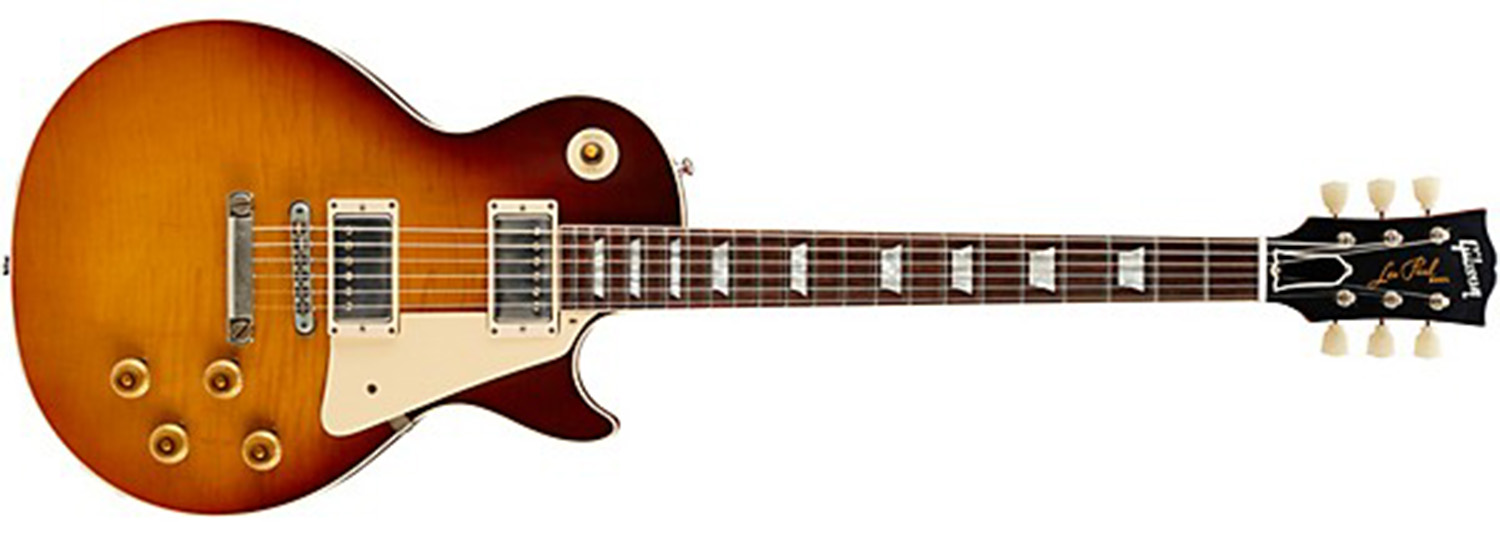
This relic of a guitar is a faithful recreation of the legendary 1959 Les Paul, dubbed among musicians as the ‘Holy Grail’ of guitars.
Built with the finest materials – a solid mahogany body and an artistically figured maple top, coupled with an Indian rosewood fingerboard – it’s an eye-catching piece.
Its CustomBucker pickups, alongside a hand-wired harness featuring paper-in-oil capacitors, showcase the true essence of the renowned PAF tone.
Marked by its hide-glue construction, extended neck tenon, and vintage-style Kluson tuners, its replica convincingly replicates the original model’s authenticity.
Complementing the overall experience is a thin VOS nitrocellulose lacquer finish that adds a rare vintage charm.
Beyond an alluring classic aesthetic, meticulous recreation has occurred even on the component level.
Its modern bridge pickup, CustomBucker Alnico III Humbuckers, is a convincing stand-in for the hard-to-find ’50s PAFs. This guitar reprise offers more than just a unique playing experience; it also carries forward a revered piece of music history.
- My Review
Embarking on a journey with this guitar was akin to traveling back in time; it successfully captured the aura and the distinctive appeal of a vintage 1959 Les Paul model.
Holding it, I was instantly struck by its well-crafted design, featuring an exquisite mahogany body and an artistically figured maple top that materialize its boasted aesthetic appeal.
After spending more time with it, I appreciated its aesthetics and construction’s flawless quality.
Details such as the hide-glue construction, vintage-style Kluson tuners, and a thin VOS nitrocellulose lacquer finish created more than just a visual appeal; they constructed an authentically touchable past.
Sure, it isn’t the original, but its resemblance is uncanny.
Drawing my attention to the technical aspects, its mesmerizing sound production was instantly admirable.
Whether played acoustically or amplified, the resonance was unmistakable, almost breathing life into each note.
CustomBucker pickups were instrumental in enhancing the tonal fluids, wrapping them up in the legendary PAF tones Gibson’s always been celebrated for.
It was interesting to learn how Gibson didn’t rely on hard-to-find ’50s PAFs.
Instead, they equipped this guitar with CustomBucker Alnico III Humbuckers, demonstrating a fine understanding of the original sound dynamic.
Regarding playability, I can’t overlook how its authentic ’59 Medium C profile neck effortlessly fits my hand – a surprising comfort considering its vintage makeover.
Precision is evident from the fingerboard, buffed to silk-like smoothness, to the frets dressed to perfection for optimized playability.
Being a firm believer in the fact that every tool displays the mark of its maker, I found this Gibson reissue to be a proud embodiment of Gibson’s prominent history and persistent commitment to quality.
While I played, I sensed I was holding a piece of heritage, remarkably maintained and faithfully echoed in a contemporary model – a testimony to Gibson’s legacy that blends the past and present masterfully.
- Pros:
- Meticulous vintage replication for authenticity.
- Remarkable resonance in both modes.
- Exceptional construction with premium materials.
- Cons:
- Pricey, may not be affordable for all.
- No deviations or updates from original model.
- Lack of color options.
My final verdict is that the Gibson 1959 Les Paul Standard Reissue Electric Guitar is an impeccable reprieve of a legendary instrument, dexterously crafted to transport you back to a distinctive era while delivering superior tonal quality.
While its high-end price tag and strict adherence to the original may be considered setbacks by some, these also contribute to its elite status.
The musicians who appreciate the charm of the authentic 1959 Les Paul sound, look, and feel will find that this guitar values every penny of its worth.
It doesn’t just recreate— it revives a piece of cherished music history.
Gibson Dave Mustaine Flying V EXP Electric Guitar
High-performance electric guitar with exceptional aggressive tone.
This electric guitar, designed in collaboration with Megadeth’s frontman, delivers a powerful, heavy sound. It’s equipped with high-output pickups designed for aggressive tone and massive distortion. The classic “Flying V” body shape, robust mahogany body, and fast-playing mahogany neck make it a high-performing tone machine for serious rock guitarists.
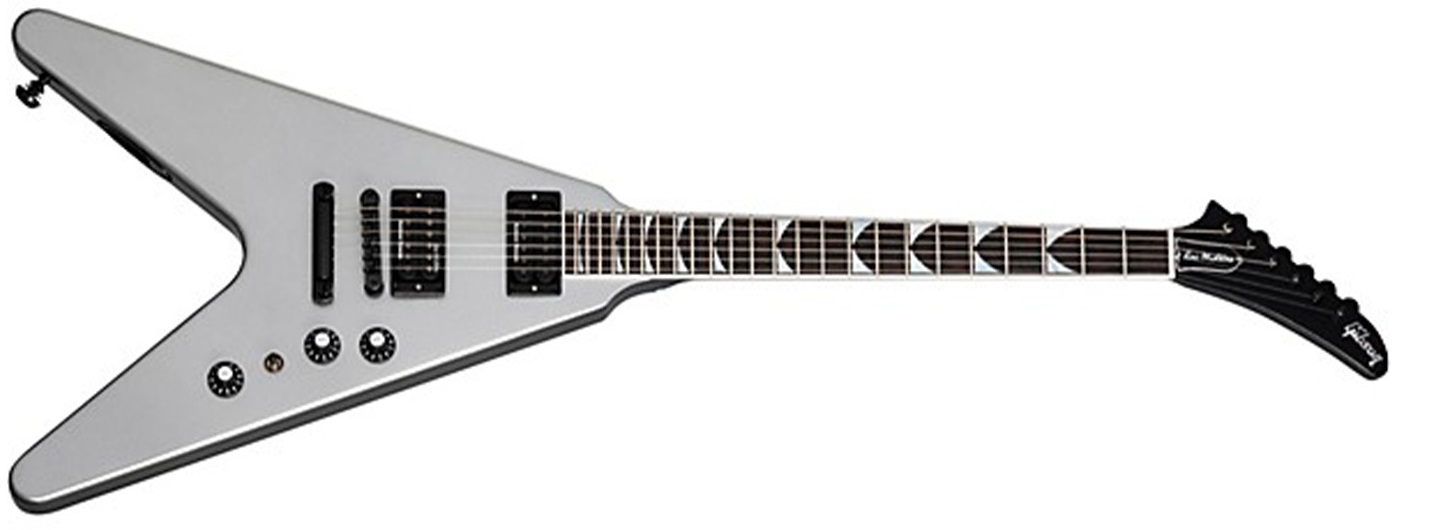
Expertly crafted with Dave Mustaine of Megadeth, this distinctive electric guitar offers a heavy, potent sound that’s signature to the band’s style.
Its eye-catching “Flying V” shape further accentuates its powerful demeanor, with its durable mahogany body and rapidly playable mahogany neck.
Ebony adorns the fingerboard, ensuring swift and smooth playability.
Made in tandem with Mustaine, the Seymour Duncan Thrash Factor, and ’59 Model SH-1 humbucking pickups beautifully capture the icon’s tone from the Rust in Peace album.
Stay impeccably tuned with Grover Mini Rotomatic tuners and the steadfast Nashville Tune-O-Matic bridge that withstands even the roughest riffs.
At its heart, this Flying V EXP is perfect for committed rock guitarists – an unrivaled tone machine.
On a larger stage, it’s built for the grind of touring and frequent performances.
With its fierce profile, flexible controls, and high-grade electronics, the guitar embodies the audacity, grit, and skill of Mustaine and his legendary status.
- My Review
From the first moment I held the Gibson Dave Mustaine Flying V EXP electric guitar, I knew it was something special.
It’s not simply a guitar, but a manifestation of power and attitude fitting of a rock legend like Dave Mustaine.
Every feature of this instrument is meticulously crafted to enhance performance and deliver a robust, heavy sound reminiscent of the classic Megadeth sound.
I strummed the guitar and felt the raw power emanating from the Seymour Duncan Thrash Factor humbucking pickups.
The pickups offer a tight, aggressive tone with substantial distortion unparalleled in many other guitars I’ve tried.
Adjusting the volume and tone controls opened many sonic possibilities, from warmer, vintage tones to full-on sonic assaults.
However, despite its impressive performance, the guitar has challenges.
It tended to detune too easily during intense playing sessions, requiring regular adjustments to stay pitch-perfect.
It’s a minor annoyance but worth considering if you plan on playing heavy or doing pitch harmonics.
As for the aesthetics, the “Flying V” design makes it a striking presence on any stage.
The brilliant nitrocellulose lacquer finish adds an elegant touch, but I noticed a few minor defects in mine – a small dent in one of the edges and corners where the finish did not seem perfect.
Such small issues, however, do not significantly interfere with the overall performance.
Additionally, while playing comfort is subjective, I appreciated the slim mahogany neck and compound radius ebony fingerboard, facilitating swift and smooth playing.
Its weight balance felt just right, not too heavy to be burdensome but substantial enough to maintain a steady grip.
Ultimately, the Gibson Dave Mustaine Flying V EXP offers exceptional value for its price point, embodying the essence of rock and metal music through its design, performance, and sound.
- Pros:
- Powerful, distinct heavy sound.
- High-performance Seymour Duncan pickups.
- “Flying V” design for attitude and presence.
- Cons:
- Requires frequent tuning with intense play.
- Minor finish imperfections in some areas.
- Action adjustments may be needed.
My final verdict is that the Gibson Dave Mustaine Flying V EXP electric guitar is a high-performance instrument that successfully embodies its namesake’s aggressive sound and attitude.
Despite minor flaws and the need for frequent tuning, the guitar’s powerful tone, high-quality pickups, and distinctive “Flying V” design significantly elevate its overall rating.
It provides substantial value, especially considering its mid-range price point.
Whether you’re a Megadeth fan or a guitarist looking for an instrument with a heavy, distinct sound, this guitar is a worthwhile consideration.
Gibson Les Paul Traditional Pro II ’50s Electric Guitar
Classic design with superior tonal quality and craftsmanship
This vintage-style guitar combines a solid mahogany body with an AA figured maple top for authentic resonance. The Gibson Les Paul 60’s Bourbon Burst boasts a slim taper 60’s-style mahogany neck, hand-wired electronics and Burstbucker 61R and 61T pickups loaded with AlNiCo V magnets. Alongside its classic-style Tune-O-Matic bridge, you’ll find reliable Grover Rotomatic “Kidney” tuners and a hardshell case included.
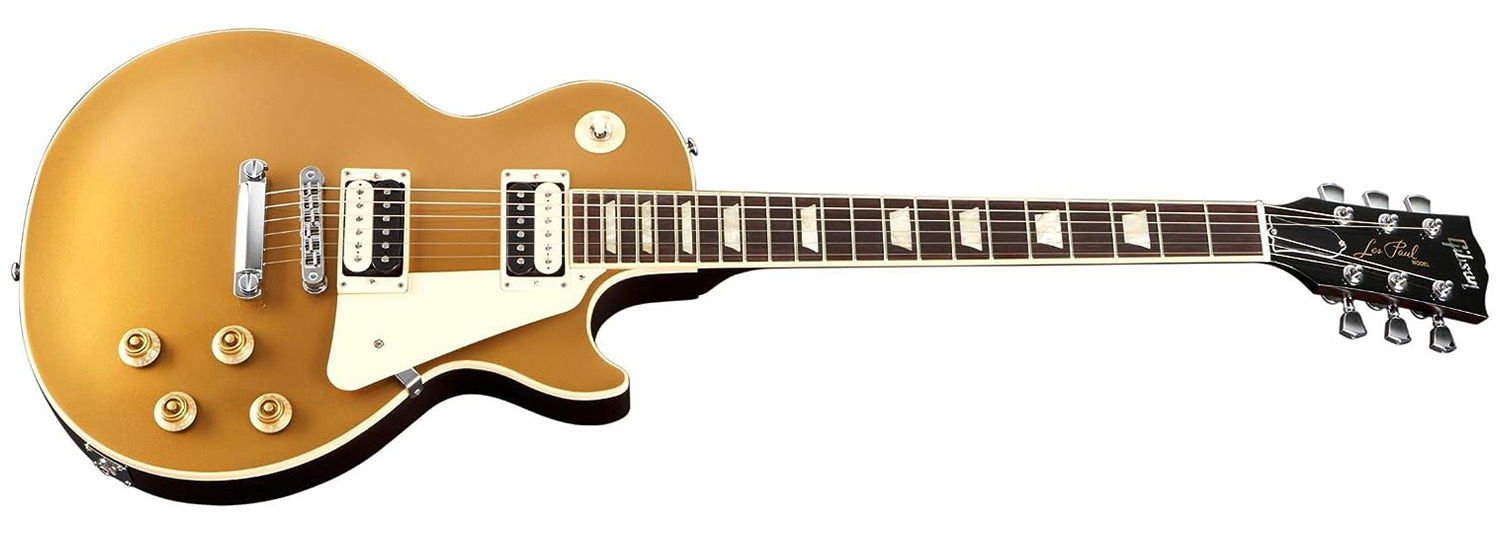
Gibson’s Les Paul Traditional Pro II is an impressive electric guitar aimed at serious music makers.
Its standout feature is an adjustable boost of up to 10 decibels that can power up solos and give a distinct tone to chord sequences, depending on what settings you have on your amp.
It also introduces a ‘Super TM57′ bridge pickup in the Trad Pro, providing a wider frequency response with stronger output.
Another clever feature is the innovation of push/push pots.
These allow you to easily activate the guitar’s coil splits and boost the circuit.
This guitar embraces a single-coil tone, always pursued by purists, through a straightforward split coil-splitting mechanism.
Visually, it draws inspiration from Les Pauls of the 80s and 90s, sporting a polished high-gloss lacquer on the top and smoothly finished back, sides, and neck.
This blend presents a great feel to the touch while allowing optimum resonance of the instrument’s wood—an ideal balance of maple and mahogany.
This guitar also introduces a period-correct creme-colored pickguard that adds a nostalgic visual appeal.
The item is right-hand oriented and rocks a Tune-O-Matic bridge system.
Gibson also offers the standard black snakeskin case for each Les Paul Traditional, ensuring that this beautiful instrument can be safely transported.
- My Review
This Gibson Les Paul Traditional Pro II ’50s Electric Guitar had a truly magnificent look from the moment I set my eyes on it.
Its high-gloss lacquer finish on the top and satin finish at the back and sides provided a nostalgic journey to the 80s and 90s Les Paul classics, and the gold color had a luxurious aura.
Straight away, I noticed the guitar’s easy-to-use push/push pots.
These triggered coil splits and a boost circuit offered unexpected versatility.
Experimenting with these allowed me to tease its multiple tonal personalities to the surface, providing clean single-coil sounds to thick, rumbling humbucker tones.
My solos never sounded better, thanks to the user-adjustable 10-dB boost.
Whether I was indulging in melodious single-note picking or getting those chords to growl dirty, the additional power and frequency range pumped into the sound was incredible, giving my performances unexpected depth and drama.
One unique aspect of this model I loved was the new ‘Super TM57′ bridge pickup that debuted in the Trad Pro, broadening the guitar’s frequency response with an enticing increase in output.
While gushing about Les Paul’s sound, I should mention that it feels excellent in my hands.
I found the ‘50s neck profile comfortable to grip, and the Grover locking tuners were simple to adjust, holding the tune remarkably well.
Even the little extras, such as the period-correct cream-colored pickguard and the vintage Gibson top hat knobs, gave this guitar a unique aesthetic appeal, perfect wherever I played.
Beyond the usual high-quality craftsmanship, there was something special about this Gibson Les Paul.
Its warmth and clarity, combined with its old-world charm and innovative upgrades, took my music on an unexpected, exhilarating journey.
- Pros:
- User-adjustable 10-dB boost offers versatility.
- Super TM57 pickup widens frequency response.
- Comfortable ’50s neck profile and Grover locking tuners.
- Cons:
- May be pricy for beginner players.
- Coil split feature might require adjustment period.
- High-gloss lacquer may be susceptible to smudging.
My final verdict is that the Gibson Les Paul Traditional Pro II ’50s Electric Guitar is a classic yet modern instrument perfect for music enthusiasts who desire a remarkable blend of vintage design, high-quality craftsmanship, and innovative performance features.
It might require some getting used to and may not be the cheapest option on the market, but this guitar is an investment worth considering for those seeking that unique Les Paul sound and feel.
Gibson Dove Original Acoustic-Electric Guitar
Versatile, balanced tone with powerful, clear projection.
This guitar’s iconic square-shoulder design creates an extraordinary balance of warmth and clarity, making it perfect for any musician. Its solid Sitka spruce top and flame maple sides ensure a powerful sound projection. It comes equipped with an LR Baggs VTC pickup system for accurate amplification.
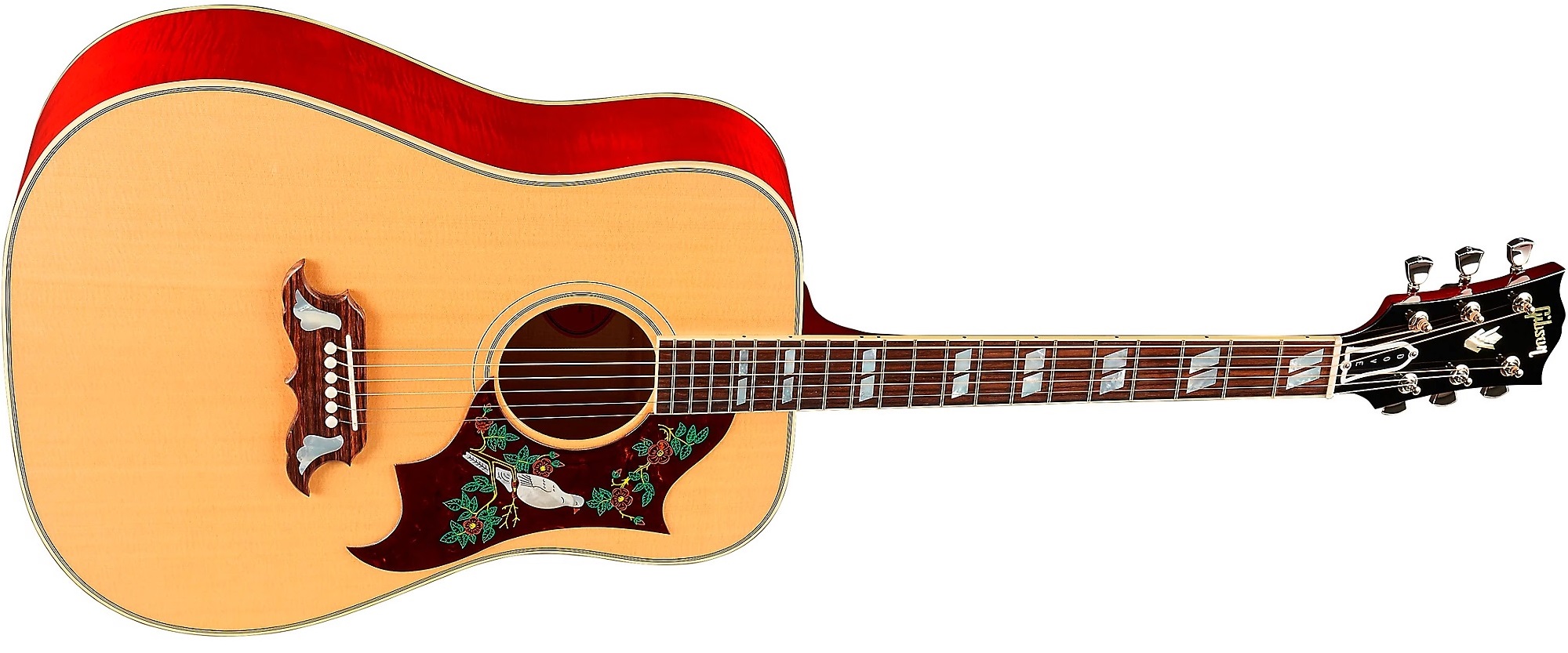
Get ready to fall in love with an acoustic-electric guitar cherished worldwide and steeped in music history – the Gibson Dove Original.
Its design is unmistakably vintage, dating back to the 60s, and known for its signature square-shoulder design, renowned for its balanced sound, resonating beautifully with every musical style.
Its amazingly resonant and dynamic range can easily cater to finger pickers, strummers, and pickers alike.
The heart of this guitar’s tone lies within its solid Sitka spruce top, delivering a powerful punch that collaborates perfectly with the bright, crisp tones of the flame maple back and sides.
Its superior sound is captured authentically with its LR Baggs VTC pickup system.
Its timeless features, including a bone nut and saddle, nickel Grover tuners, and an engraved hand-painted dove pickguard, enhance its uniqueness.
Its double antiqued binding and traditional truss rod cover stamp its relevance in the history of music.
- My Review
What an experience!
Playing this Gibson Dove Original Acoustic-Electric guitar feels as powerful as it sounds.
As you hold it, the square-shoulder design isn’t just a stylish nod to the ’60s; it’s functional, too, creating a versatile tone that’s warm yet clear.
Whether I’m in a country-picking mood or choosing to strum some rock classics, the Dove Original responds to each stroke with a balanced resonance that speaks volumes about its build quality.
Now, what caught my attention was the punch that this guitar delivered.
Thanks to its firmly set Sitka spruce top, it has an impressive voice.
Combined with the maple back and sides, this guitar slices through any ensemble with an honest, bright tone that’s impossible to overlook.
Perfect for session recording or performing live, it’s a standout performer.
As I transitioned to amplified play, the LR Baggs VTC pickup system performed wonderfully, capturing every dynamic range and frequency response with the precision I’d expected from Gibson’s innovative electronics.
From the softest fingerpicking to vigorous strumming, the guitar’s character remains consistent and alive, respecting the integrity of the unamplified sound.
Then, there’s the aesthetic appeal of this guitar.
Every glance on stage or in my studio lit my heart ablaze.
The bone nut and saddle, the nickel Grover tuners, and the engraved pickguard sporting a hand-painted dove – these details are not just aesthetically pleasing; they add to the guitar’s distinctive feel and tone.
And it’s not only about looks and sound; the guitar is built to resonate peace and harmony, aligning perfectly with its symbol.
Its timeless details, combined with its steadfast reliability, really reinforce its standing in music history.
- Pros:
- Stunning and versatile sound quality.
- LR Baggs VTC pickup system.
- Evergreen iconic design, classic features.
- Cons:
- Nitro finish may check and crack over time.
My final verdict is that the Gibson Dove Original Acoustic-Electric Guitar is an excellent, versatile instrument, steeped in musical history.
Its superior sound quality, combined with its powerful amplification system and iconic design, make it a standout.
Despite its tendency for the nitro finish to wear over time, it remains an incredible instrument for guitarists of all levels.
It’s a worthy addition to any collection and conveniently caters to a range of musical styles.
Gibson ’70s Flying V Electric Guitar
Classic ’70s tone meets modern playing comfort.
An iconic reissue with ’70s Tribute Burstbucker pickups defines the rock sound. Slim taper neck and ergonomic design offer modern playability. High-end details include Grover tuners, aluminum bridge, and protective black pickguard, encapsulating a perfect blend of retro aesthetics and up-to-date comfort and playability.
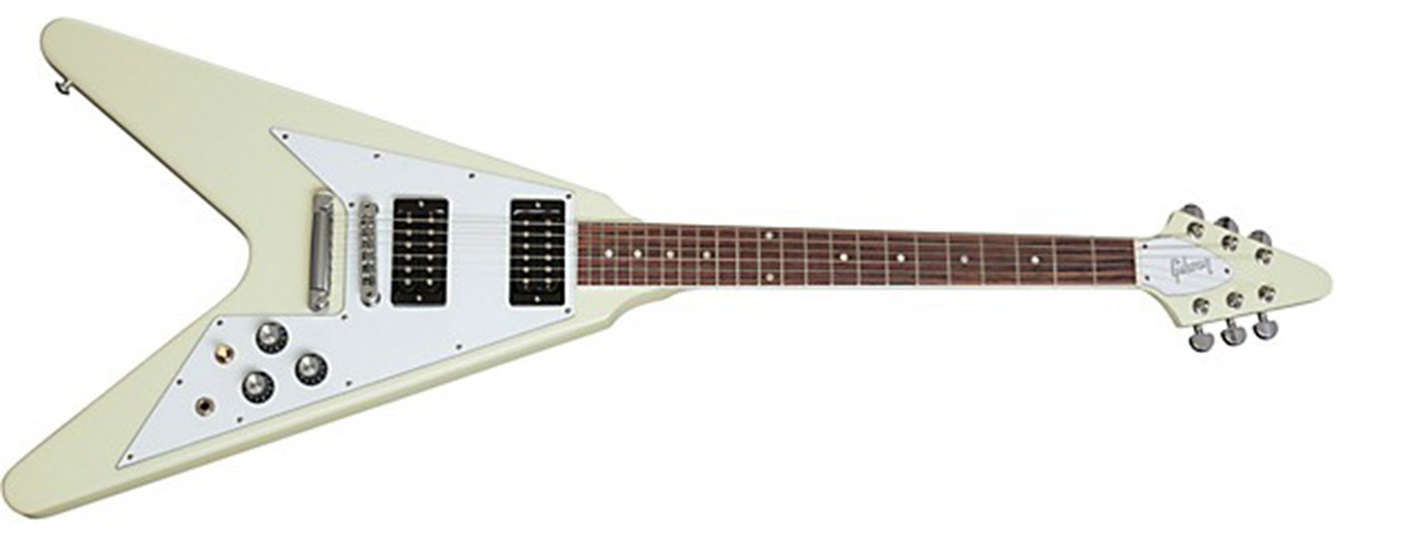
Let’s take a look at the Gibson ’70s Flying V Electric Guitar.
Adorned first in a shiny, classic white finish, this rock legend pays homage to an era defined by its music.
Its iconic wing-style, asymmetrical body is crafted from mahogany and topped with maple.
The instrument is not just about aesthetics as its slim taper in-built neck is redesigned for modern comfort and facilitating heavy chords and quick melodic runs.
The highlight of this model is the ’70s style Tribute Burstbucker pickups, which have been hand-wired with Orange Drop capacitors.
These pickups rev up the heavy rock crunch and shape it into soaring lead tunes.
Fancy details like Grover tuners, a tune-o-matic bridge, a stop tailpiece, and a black pickguard add to the guitar’s versatility while retaining its vintage vibe.
Its double cutaway design and solid mahogany body attest to its sturdiness and durability.
- My Review
When I first laid my hands on the Gibson ’70s Flying V Electric Guitar, I was gripped by nostalgia.
It was the physical embodiment of rock history, with its classic white finish echoing an era defined by electric guitars and soaring riffs.
The iconic asymmetrical wing-style body was nothing short of stunning.
Crafted from mahogany and topped with maple, it exuded sturdiness and durability.
I found it comfortable when I ran my fingers along the slim taper neck, redesigned for the modern-age player.
It was easy to pull off complex chords, nimble runs, and wide bends – a testimony to the guitar’s adept design.
Appeal aside, the Gibson ’70 overall beautiful design was just the beginning.
What caught my ear were the ’70s-style Tribute Burstbucker pickups.
Hand-wired with Orange Drop capacitors, these pickups captured the quintessential heavy rock crunch that defined the ’70s.
They provided a versatile array of tones, delivering everything from a hard rock edge to melodic lead lines.
The overwhelmingly robust sound gave me chills.
Of course, the Gibson Flying V doesn’t compromise on function, either.
Many premium features, including Grover tuners and a tune-o-matic bridge, bolster it.
The added stop tailpiece increases dynamic sustain, making each note resonate for a holy period, while the black pickguard safeguards the guitar’s exuberant finish.
However, a nitpick could be the reported nitro issues with these guitars.
While I didn’t experience any during my usage, I hope it holds up with extended play – only time will tell.
Remarkably, the Gibson ’70s Flying V integrates classic design aesthetics with modern playability, retaining its beloved vintage vibe while catering to the evolving needs of today’s musicians.
This model is then a prolific blend of historical tradition and contemporary innovation.
- Pros:
- Ideal mix of vintage style and modern playability.
- Impressive ’70s style Tribute Burstbucker pickups.
- Durable and sturdy mahogany body.
- Cons:
- Potential durability issues with nitro finish.
My final verdict is that the Gibson ’70s Flying V Electric Guitar is a solid testament to the brand’s craftsmanship, combining nostalgia with modern enhancements.
It captures the iconic’70ss rock sound with its proprietary Burstbucker pickups while ensuring comfortable playability with its slim taper neck.
Despite the minor potential concern with finish durability, this guitar largely impresses with its unique aesthetics, tonal versatility, and uncompromising construction quality.
This electric guitar could be a worthwhile addition for those looking to revel in a slice of rock history with contemporary upgrades.
Gibson J-45 Standard Acoustic-Electric Guitar
Durable with high-quality sound and classic design.
This acoustic-electric guitar pairs a mahogany body with a Sitka spruce top for reliable, recognizable tone. Its SlimTaper neck is conveniently designed for electric players transitioning to acoustic. Equipped with a discrete, easy-to-use L.R. Baggs VTC soundhole-mounted pickup, it’s ideal for gigging performers.
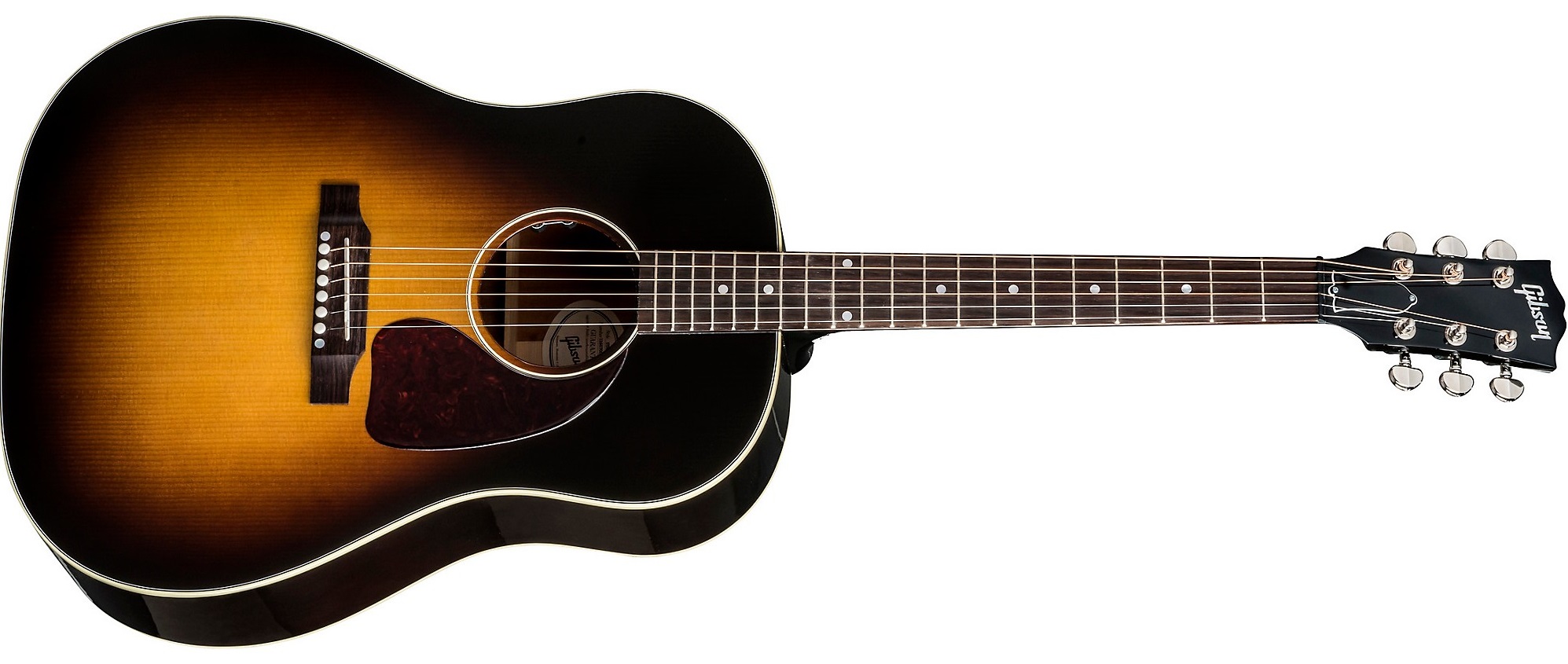
Born in 1942, the Gibson J-45 has a hefty reputation with a rich history.
It’s been carried by greats like James Taylor and Bruce Springsteen, not to mention modern icons like Ben Gibbard.
This 2019 acoustic-electric rendition keeps its tradition alive, sporting a mahogany body and a Sitka spruce top, all adorned in a Vintage Sunburst gloss finish.
The Sitka spruce top is often chosen for steel-string guitars and ensures a broad dynamic range and quality projection.
Coupling this with mahogany adds warmth, resonance, increased sustain, and a low-end boost, making it well-suited for fingerpicking and strumming.
The classic hand-scalloped X bracing is a notable inclusion, reinforcing its sound quality.
The guitar’s neck is mahogany and carries a rosewood fingerboard, designed with a SlimTaper feature that slims as you go upwards, ultimately facilitating a smoother transition for electric players shifting to acoustic.
It’s also fitted with nickel Grover Rotomatic tuning machines to help maintain its tune.
An L.R. Baggs VTC pickup is embedded for excellent sound delivery for the performers and ready-to-hit-the-stage singer-songwriters.
With this guitar, you’ve got accessible and effective volume and tone controls at your disposal.
Expect no less from a brand like Gibson, which delivers popular fixtures within its Standard Series.
Its range includes models from its illustrious history to the most creative innovations of the modern era.
- My Review
When I picked up the Gibson J-45, I instantly appreciated its history.
Brimming with tradition, this acoustic-electric guitar is a robust piece, and its build exudes durability.
The mahogany body in Vintage Sunburst gloss finish combined with the Sitka spruce top pours out a unique, unrivaled aesthetic.
One thing I particularly loved about this guitar is the Sitka spruce top’s broad dynamic range and its exceptional projection.
These qualities, paired with the warm resonance of mahogany, offer a rich tonal balance that’s a dream come true, especially when strumming or fingerpicking.
One cannot discount the thoughtfulness behind the hand-scalloped X bracing that reinforces sound quality.
It enriched my playing experience, making every stroke and strum sound incredibly vibrant and full.
As I advanced toward the guitar’s neck, I noticed the SlimTaper design.
This proved instrumental for an electric player like me transitioning to acoustic.
Moving up the rosewood fingerboard was a slick experience.
The slimming neck allowed for comfortably fast and seamless playing.
Thanks to the nickel Grover Rotomatic tuning machines, its tuning durability also enthralled me.
They made sure my tune stayed consistent throughout my jam session.
Now, let’s talk electronics.
The L.R. Baggs VTC pickup embedded into the guitar changed the game.
Hitting the right notes and delivering exceptional sound was effortless, making it a joy to play and perform with.
The volume and tone controls were stack-on, helping me fine-tune my sound without sweat.
Throughout my experience, I realized why the Gibson brand is revered.
The J-45 demonstrated what the Standard Series is all about.
It carries a touch of historical elegance and the innovative trimmings of the modern era.
Playing this guitar was like being a part of a rich narrative that has evolved through the ages.
The Gibson J-45 is remarkable, demonstrating both legacy and creativity.
- Pros:
- Broad dynamic range and exceptional projection.
- SlimTaper design aids in smooth transition.
- Durable tuning with Grover Rotomatic machines.
- Cons:
- L.R. Baggs pickup might be complex for beginners.
- Historical design may not suit modern aesthetics.
- Hefty, which could affect portability for some.
My final verdict is that the Gibson J-45 Standard Acoustic-Electric Guitar is a phenomenal blend of tradition and innovation.
It brings thoughtful modifications to time-proven designs, offering a perfect investment for any music enthusiast.
Despite minor hurdles, its rich tonal balance, reliable tuning stability, and L.R. Baggs pickup make it ideal for experienced guitarists and performers.
Gibson SG Modern Electric Guitar
An innovative electric guitar merging tradition and modernity.
This electric guitar fuses classic styling with contemporary features. Its solid mahogany body delivers resonant tone and sustain, while BurstBucker Pro humbuckers, powered by Alnico V magnets, provide output for modern music. It has high-end components like Grover locking Rotomatic tuners and a sleek Neck Profile for comfort and speed.
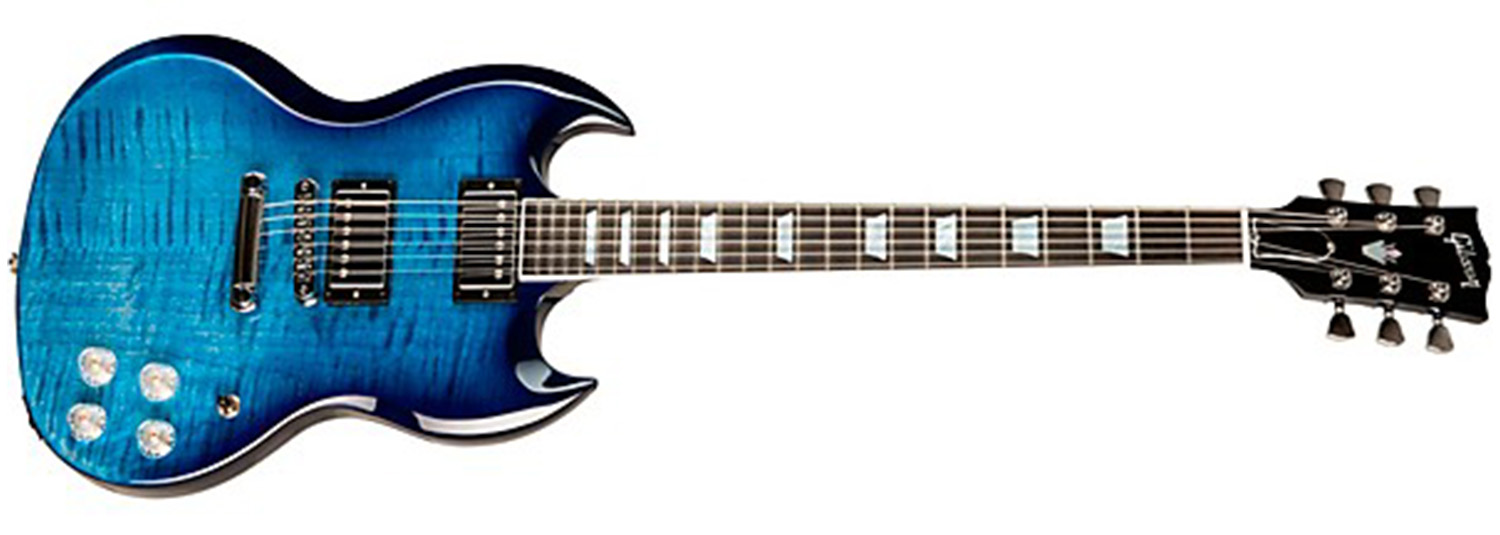
Meet the Gibson SG Modern, a game-changing electric guitar that blends timeless style with today’s desired features.
Its body is crafted from solid mahogany, a material known for its rich, resonant tone and incredible sustain, topped with striking figured maple for added visual appeal and tonal warmth.
As you glide along its authentic ebony fretboard, you’ll find 24 frets and a compound radius delivering smooth playability.
The guitar comes equipped with BurstBucker Pro humbuckers, powered by Alnico V magnets, that achieve a balance of strength and clarity to meet the demands of current music styles.
For an added sonic range, push-pull volume controls allow you to easily switch from humbucker to single-coil tones.
You’ll also appreciate the comfort and speed provided by its SlimTaper mahogany neck with an asymmetrical profile.
Lastly, upscale features such as Grover locking Rotomatic tuners, acrylic top-hat knobs, and mother-of-pearl trapezoid inlays enhance your playing experience.
- My Review
When I first held the Gibson SG Modern electric guitar, I was captivated by its elegant fusion of traditional design and contemporary upgrades.
One of the standout features is the solid mahogany body, renowned for providing a signature rich, resonant tone and exceptional sustain.
This rich tone is beautifully accented by a figured maple top, lending both aesthetic appeal and a layer of tonal warmth.
When my fingers first explored the authentic ebony fretboard with its 24 frets and compound radius, I found the playability highly fluid.
It played smoothly across a range of musical genres and styles.
Adding even more to this instrument’s versatility is the inclusion of BurstBucker Pro humbuckers.
Powered by Alnico V magnets, these humbuckers deliver a balanced output that resonates with the clarity needed for modern music genres.
What intrigued me was the push-pull volume controls, letting me switch seamlessly between humbucker and single-coil tones, adding a whole new range to my sonic palette.
The SlimTaper mahogany neck, with its asymmetrical profile, ensured that not just sound but comfort and speed of playing also took center stage in my experience with this guitar.
However, it’s not only the sounds that caught my attention but also those stylish touches, like Grover locking Rotomatic tuners, acrylic top-hat knobs, and the exquisite charm of mother-of-pearl trapezoid inlays.
These elevated my playing experience and lent the instrument an upscale appearance without compromising its classic essence.
Still, I did notice a perceived weight imbalance resulting in a neck dive.
There’s some truth to those username-free claims about the neck heaviness, leading the guitar to hang downwards if not supported adequately.
Another issue was with the neck pickup wiring, which could impact some usability.
With all these in mind, the Gibson SG Modern electric guitar stands out as a meaningful blend of tradition and progression despite room for improvement.
Its striking style, flexible sound profile, and high-end features make it a compelling consideration for any electric guitar enthusiast, although addressing the neck issue could significantly elevate its appeal.
- Pros:
- Exceptional playability with 24 frets.
- Powerful BurstBucker Pro humbuckers.
- Upscale features and design.
- Cons:
- Perceived weight imbalance causing neck dive.
- Neck pickup wiring issues.
- Individual adjustment may be required.
My final verdict is that the Gibson SG Modern Electric Guitar blends classic design with contemporary features, offering an elevated experience for guitar enthusiasts.
While there might be some challenges, such as the neck heaves or an issue with the neck pickup wiring, the exceptional sound quality and upscale features certainly make this instrument worth considering.
However, it might not suit every musician’s unique needs, and individual adjustments may be required.
Despite these setbacks, it’s undeniable that this guitar has a lot to offer in terms of playability and sound versatility.
Gibson Les Paul Junior Electric Guitar
Uncompromising tone, iconic design, exceptional craftsmanship.
This electric guitar boasts a powerful sound, thanks to its mahogany body and dogear P-90 pickup. The ’50s-style neck and wraparound bridge ensure comfortable playability and solid intonation. Features include simple yet effective controls for shaping your tone and a vintage-inspired, single-cutaway design.
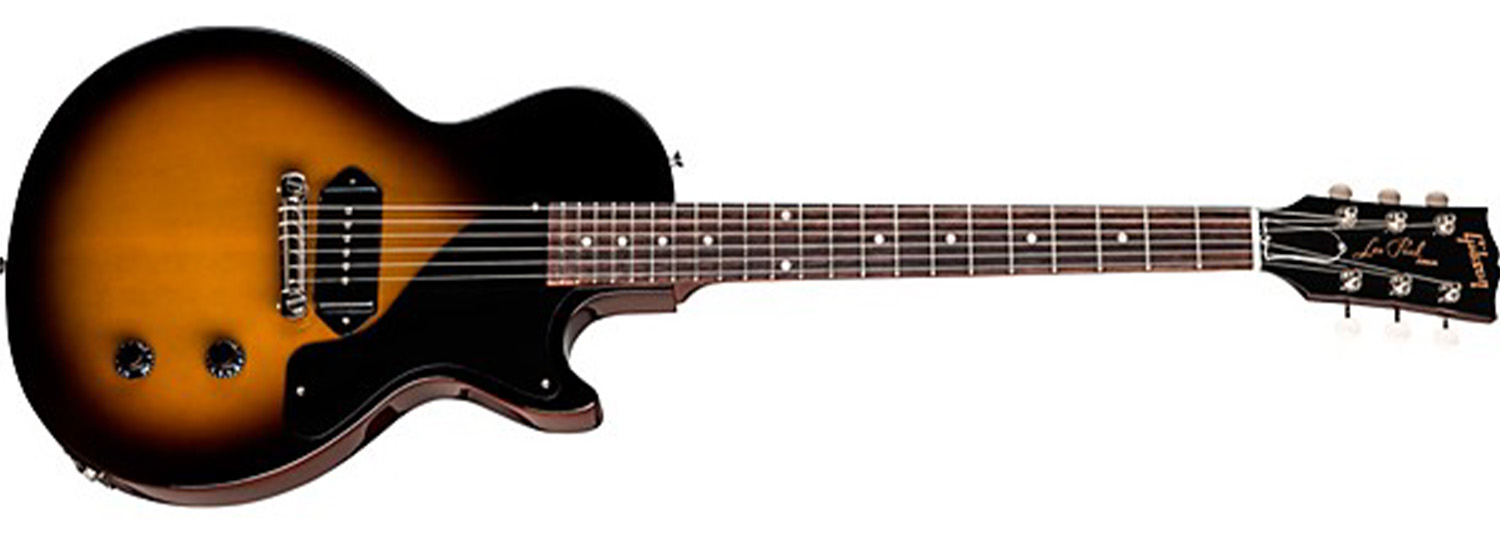
It’s a tribute to Gibson’s influential era in the 50s, and it doesn’t skimp on any of the fantastic qualities of that period.
The body and neck made of mahogany wood produce a warm, resonant tone that’s rich and full.
A distinct feature of this model is its single cutaway design which allows unrestricted access to the upper frets.
Gibson employs a classic dogear P-90 pickup for this model, employing an alnico V magnet and enamel-coated coil for an array of sounds, from clean and bright to smooth, gritty overdrive.
This guitar features a minimalist control layout with just one volume and one tone control.
The comfort-focused ’50s-style neck profile will benefit those who spend lengthy sessions playing chords and single notes alike.
Lastly, a wraparound bridge gives you rock-solid tuning across your playing range.
The Gibson Les Paul Junior Solidbody Electric Guitar is undoubtedly a charming mix of modern and vintage design.
- My Review
Upon picking up this Gibson Les Paul Junior Solidbody Electric Guitar, one can’t help but be transported back to the Golden Era of the 1950s.
Its pristine design faithful to the era is an immediate sign of Gibson’s commitment to high-quality craftsmanship.
A key feature that truly stood out was the mahogany wood construction of its body and neck – it produced a depth and richness, a full-bodied resonance that was utterly delightful, just what you’d expect from Gibson.
Strumming through the range of tones was an enchanting journey.
Thanks to the single dogear P-90 pickup, capable of generating an array of vintage-inspired sounds.
Everything from crisp, clear notes to smooth, warm overdrive was available right at the fingertips, making this a versatile tool for musicians of diverse genres.
One strikingly simple, yet effective component of this guitar is its minimalist control layout.
With a single volume and tone control, I found it very convenient to shape my sound effortlessly.
A gentle roll of the knob opened up a whole spectrum of tonal possibilities, adding to the guitar’s innate versatility.
The ’50s-style neck profile is rounded and comfortable, fitting naturally into the hand and encouraging extended plays.
Chords and single notes rolled off with ease, reinforcing this model as an excellent choice for both beginners and seasoned players.
The wraparound bridge is another commendable feature that stood out.
It ensures solid intonation and reliable tuning stability across the fretboard.
Yet, I wish Gibson would pay more attention to the finishing – the one flaw I could discern was the uneven gloss, which seemed hasty in places, particularly along the neck.
Finally, a seamless blend of modern convenience and vintage design made the Gibson Les Paul Junior not just an instrument but an experience.
It’s a testament to Gibson’s legacy and dedication to producing exceptional guitars.
Despite minor imperfections, it’s a genuinely pleasurable instrument to play.
- Pros:
- Versatile vintage-inspired P-90 pickup.
- Comfortable ’50s-style neck profile.
- Reliable wraparound bridge for solid intonation.
- Cons:
- Finish on the neck can be uneven.
- Minimalist controls may limit sound variations.
- Single pickup design might not suit all.
My final verdict is that the Gibson Les Paul Junior Solidbody Electric Guitar is a remarkable fusion of vintage design and modern functionality.
Despite minor setbacks, primarily from its finish and minimalist controls, the guitar’s superior sound quality, comfortable playability, and solid build make it a worthwhile instrument for both beginners and seasoned musicians.
Gibson ES-339 Electric Guitar
High-quality, resonant tone in a compact design..
This electric guitar delivers resonant, vintage tones with its semi-hollow maple and poplar body and dual 57 Classic humbuckers. It features a comfortable rounded C-shaped mahogany neck for seamless playability. Comes with robust hardware and high-performance upgrades, including a hardshell case.
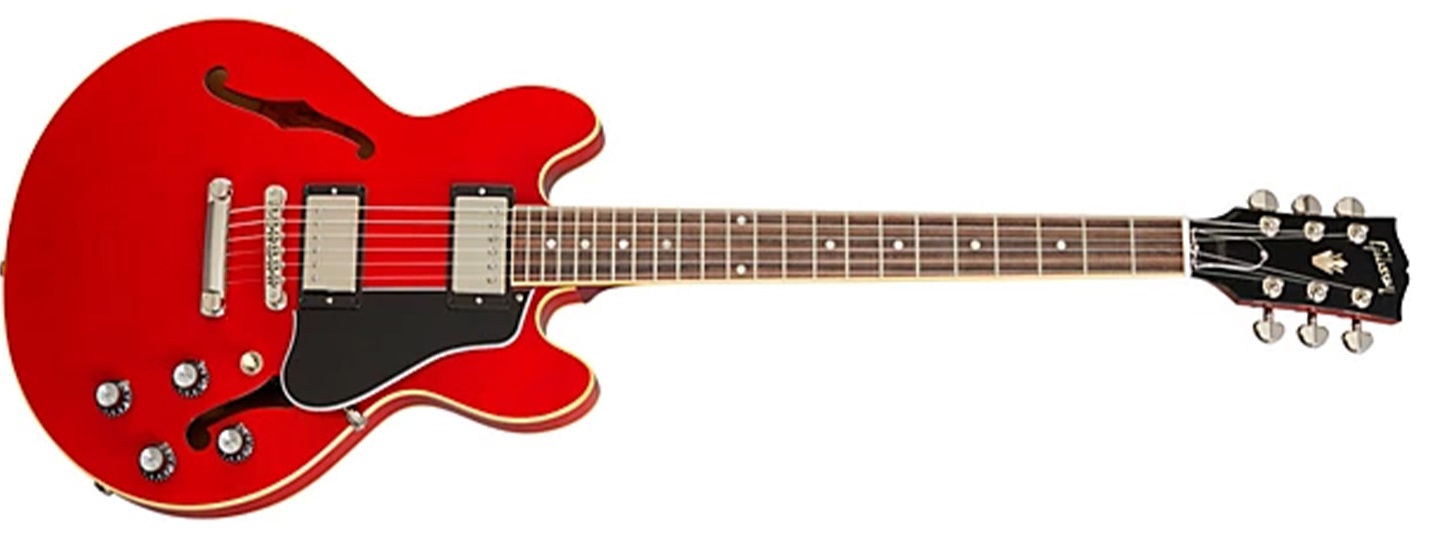
Immerse yourself in the world of Gibson electric guitars with the ES-339 model.
Designed with a semi-hollow framework of maple and poplar, the guitar is lightweight, resonating with an irresistible woody tone.
The dual 57 Classic humbuckers amplify this tone, echoing the signature Gibson sound.
They authentically channel vintage PAF humbuckers from the ’50s.
Whether you’re strumming clean chords or ripping through rock solos, these pickups always perform.
The craftsmanship doesn’t end there.
This model features a mahogany neck, engineered with a rounded C-shape.
This design offers a slender and quick feel familiar to most players.
Complementing the neck is a rosewood fretboard designed for smooth bends and low-action performance.
The 22 medium-sized frets offer versatility across a myriad of musical genres.
Then there is the robust hardware, encompassed by notable high-performance upgrades.
Thanks to the Grover Rotomatic tuners with kidney buttons, stability is guaranteed.
The tune-o-matic bridge, coupled with a stop tailpiece, also enhances string vibration.
Nickel-finished hardware and a transparent ebony finish add a final touch of class to this magnificent instrument.
- My Review
From the moment I first held the Gibson ES-339 Electric Guitar, I was captivated by the lightweight feel and compact size, which fit snugly in my arms.
It stood as a testament to the pinnacle of Gibson’s high-caliber design, marrying timeless aesthetic values with modern player-oriented features.
Grounded on a semi-hollow framework of lightweight woods, including maple and poplar, every strum echoed with rich, woody resonance.
I was particularly struck by the depth of tone the 57 Classic humbuckers offered.
They produced a harmonious blend of vintage and modern Gibson sounds, with an amazing capability of channeling the iconic PAF humbuckers from the ’50s.
Playing this guitar felt like a dream, largely owing to the mahogany neck engineered in a rounded C-shape.
The neck was comfortably slim and surprisingly fast, offering a tactile familiarity.
Balancing the fine construction was the rosewood fretboard, meticulously designed for smooth bends and low-action playing.
I found its 22 medium-sized frets versatile, accommodating various musical genres.
Among the notable features I appreciated were the high-performance upgrades, from the robust hardware to the Grover automatic tuners.
Every tuning session felt secure and precise, freeing me to focus on the music.
A standout facet was the tune-o-matic bridge, coupled with a stop tailpiece, which noticeably enhanced the string vibration for an immersive playing experience.
The Gibson ES-339 proved memorable with its stellar blend of top-notch features, not only with its sound quality but also with its stunning aesthetic appeal – a transparent ebony finish and flawless nickel-finished hardware.
The guitar’s design paid tribute to Gibson’s legacy while catering to the modern musician.
All these components converged harmoniously to make the Gibson ES-339 an extraordinary offering in electric guitars.
- Pros:
- Superior sound with 57 Classic humbuckers.
- Comfortable, quick rounded C-shape neck.
- Enhanced string vibration with tune-o-matic bridge.
- Cons:
- Premium price may not fit all budgets.
- No apparent cons for professional musicians.
My final verdict is that the Gibson ES-339 Electric Guitar is an exceptional instrument.
Its top-notch design and quality features provide an incomparable playing experience.
The high-end price reflects the premium features you are getting.
For dedicated musicians, professionals, or those who appreciate remarkable build quality, the investment in the Gibson ES-339 is undeniably worth it.
Gibson Custom Firebird Electric Guitar
Exceptional Gibson with incomparable style and sound.
Dressed in black, white, and gold, this Electric Guitar marries a Les Paul Custom style with iconic Firebird design. It houses powerful 490R/498T humbuckers, solidifying its status as a rock-and-roll powerhouse. It’s part of the highly-regarded Platinum Guitar Collection, guaranteeing a top-notch, limited-edition instrument.
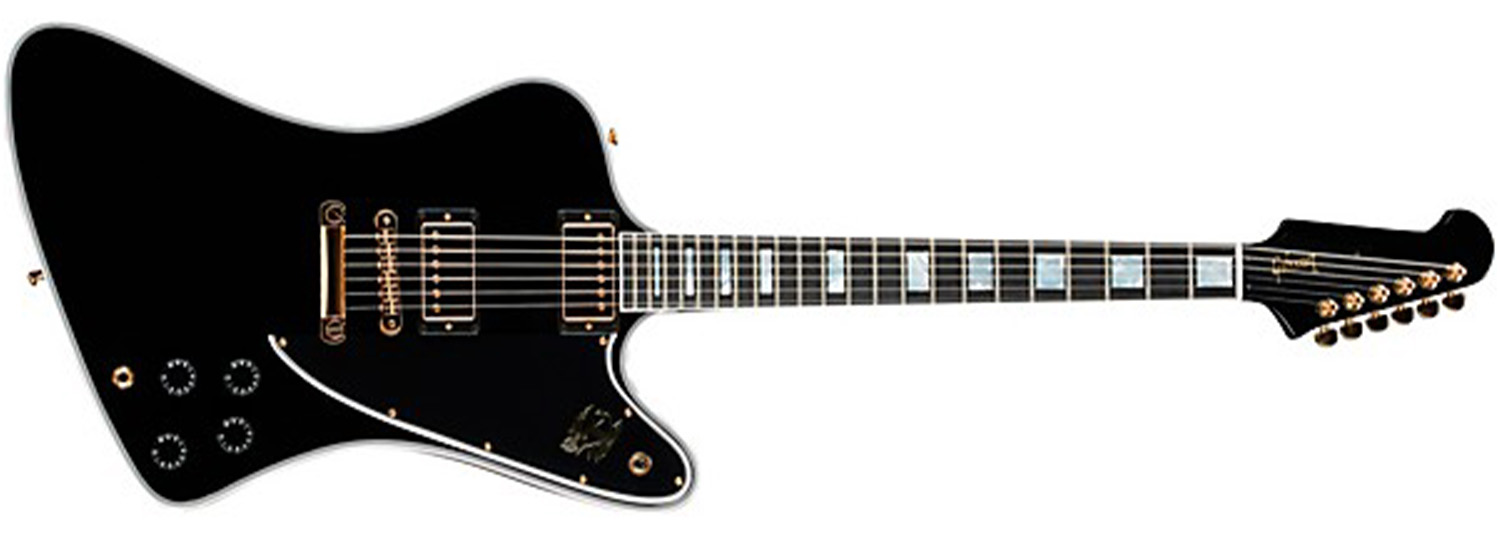
This high-end electric guitar is a magnificent display of craftsmanship, blending the elegance of a Les Paul Custom with the timeless design of a Gibson Firebird.
Striking color contrasts of black, white, and gold make it stand out for any formal occasion.
It’s fitted with top-tier 490R/498T humbuckers for a strong rock-and-roll vibe.
As part of Guitar Center’s Platinum Rooms, a revered selection of exclusive instruments, this one lends prestige to the owner.
The collection presents eye-catching pieces from major industry powerhouses and highly esteemed small-scale guitar makers.
With a firm emphasis on providing limited-edition and distinct guitars, the Platinum Collection is a haven for world-class acoustic and electric guitars.
What makes the guitar distinct is its gloss-finish, mahogany body guarded by a bound ebony fingerboard.
It relies on Gibson Custom 498T/490R humbuckers with gold covers, aided by a 3-way switch.
The bridge flaunts a gold finish, and it houses Grover Kidney tuners.
- My Review
Right from the get-go, I was taken aback by the sheer artistry of this Gibson Firebird Electric Guitar.
What you get is an electric guitar that stands out in a crowd with its striking black, white, and gold contrasts.
It feels very elegant, reminiscent of a Les Paul Custom design but with the punch of the Gibson Firebird silhouette.
It’s not just an ordinary instrument; it’s an identifier, a statement that radiates confidence and oozes charm.
Plugging it in, I was knocked back by the strong rock-and-roll vibe that the 490R/498T humbuckers produced.
This beauty is more than just a treat to look at; it’s a music powerhouse that meets challenging rock riffs with gusto.
Never once did I feel the output was deficient.
I truly appreciate how the three-way switch complements these humbuckers, granting me an ample level of control in dialing in my desired tone.
As I ran my fingers over its gloss-finished mahogany body, I was lured into the obsession that is Guitar Center’s Platinum Collection.
Sensing the texture was an absolute treat; you can tell that every piece from this selection ooze class.
This electric guitar, with its limited-edition allure, is more than an instrument; it’s a masterwork from top-tier craftsmen.
Something I must mention is the gold-finished bridge housing the Grover Kidney tuners, which I found to be as functional as they were attractive.
The tuning stability was solid throughout the time I spent with this instrument, retaining its tune even during the most vigorous rock sessions.
To round it off, I must commend the practicality of the hardshell case included, a nice touch that isn’t seen too often.
Indeed, this Gibson Firebird Electric Guitar felt like a feather in my cap, an addition to my collection that resonated with luxury, exclusivity, and unrivaled performance.
- Pros:
- Incredible artistry in guitar design.
- Strong rock-and-roll vibe from humbuckers.
- Premium build quality from top-tier craftsmen.
- Cons:
- Limited edition might be hard to acquire.
- May be costly for some budgets.
- Not versatile enough for non-rock genres.
My final verdict is that the Gibson Firebird Electric Guitar is a masterful blend of artistry and performance.
Its rock-and-roll spirit, luxurious design, and elite construction make it a captivating instrument worth every penny.
Despite being a bit geared towards rock genres and potentially challenging cost-wise, its overall charm and functionality prove that it excels tremendously as a musical asset.
So if classic style, robust sound, and exquisite craftsmanship top your checklist, this Gibson masterpiece won’t disappoint.
Gibson SJ-200 Acoustic-Electric Guitar
Iconic Gibson Guitar with Studio-Quality Sound.
This acoustic-electric guitar boasts outstanding craftsmanship with a solid Sitka spruce top and flamed maple back and sides. The built-in LR Baggs Anthem system delivers studio-quality sound on stage or in the studio. Elegant aesthetics include mother-of-pearl crown inlays and a vintage sunburst finish.
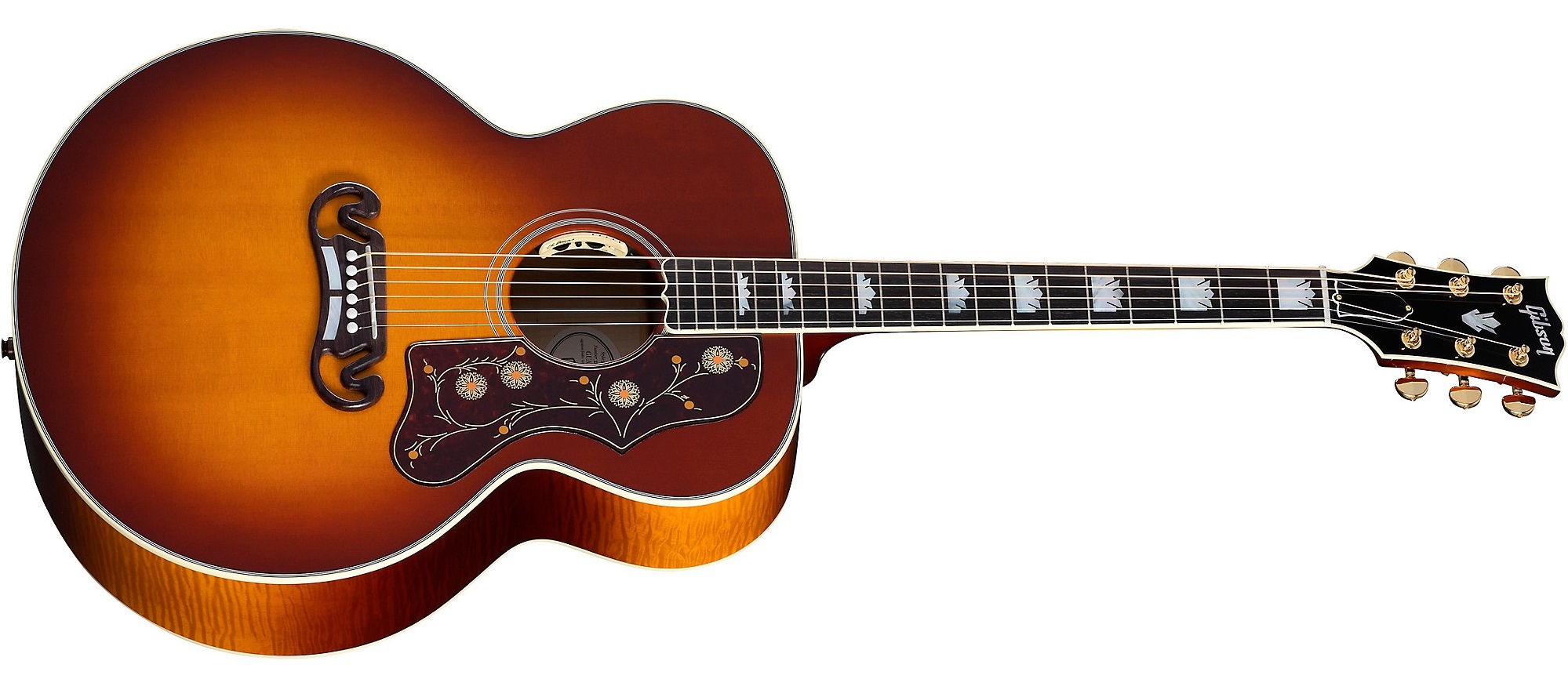
Crafted for serious musicians, this Gibson acoustic-electric guitar offers a blend of aesthetics and superior sound performance.
It strikes the perfect harmony with a body made from a combination of solid Sitka spruce top and flamed maple back and sides, offering a breadth of frequencies and remarkable dynamics.
Embedded is an LR Baggs Anthem system, a hybrid pickup system allowing full control over the amplified tone, letting performers tweak volume, bass, mids, and treble.
So whether you’re playing live or recording, this guitar enables you to capture its rich, balanced acoustic sound.
It features a slim mahogany neck with a 12″-16″ compound radius rosewood fretboard, ensuring quick and comfortable playing.
Its gold Grover Rotomatic tuners with unique kidney buttons guarantee long-lasting tuning stability.
Attention to detail is evident in the mother-of-pearl crown inlays, multi-ply binding, and the classic mustache bridge.
A tortoiseshell pickguard and a vintage sunburst finish enhance this guitar’s timeless appeal.
To keep this gem safe, a hard-shell case is included.
- My Review
Experiencing the Gibson SJ-200 acoustic-electric guitar, my initial impressions point to a level of craftsmanship that sets it apart.
Its aesthetics, a stunning combination of a vintage sunburst finish and mother-of-pearl crown inlays, are an instant attraction.
Lifting it, I’m met with a slim mahogany neck paired with a 12″-16″ compound radius rosewood fretboard that melts into my hands, enabling quick, comfortable play of both chords and single-note runs.
Striking an unplugged chord, I discovered a richness of sound courtesy of the solid Sitka spruce top and flamed maple back and sides.
The tones are balanced, full-bodied, and impressively dynamic, filling the room under my lightest touch.
Subtle finger-style methods and full-force strumming reveal the same consistency, maintaining the guitar’s robust integrity in all its acoustic glory.
Transitioning to plugging-in felt seamless with the LR Baggs Anthem system.
This hybrid pickup system with controls for volume, bass, mids, and treble brilliantly emulates the studio-quality sound I crave.
Its intricacy replicates acoustic tones as if mic’d up in a professional studio.
Playing this instrument feels akin to delving into a piece of history, courtesy of the timeless details.
The elegant mustache bridge, traditional tortoiseshell pickguard, and gold Grover Rotomatic tuners with distinctive kidney buttons are reminiscent of the golden age of acoustic guitars.
My only critique lies in its heavy body, which might disadvantage long-duration performances.
But that’s quickly overshadowed by the fact that this guitar comes with a hard-shell case, a thoughtful addition by the creators keen on preserving this musical gem.
In playing the Gibson SJ-200, I venture beyond mere performance into an immersive acoustic journey that marries history, aesthetics, and sound in an unparalleled symphony.
- Pros:
- Impressive room-filling sound dynamics.
- LR Baggs Anthem system for amplified play.
- Included hard-shell case for protection.
- Cons:
- Relatively heavy body.
- May require regular tuning.
- Price could be high for some buyers.
My final verdict is that the Gibson SJ-200 Acoustic-Electric Guitar is an impressively crafted instrument that embodies aesthetics and exceptional performance.
Its features, from the amplified system to premium materials, make it a worthy possession for any serious musician.
Despite its relatively heavy body, it provides an immersive playing experience where comfort, sound, and style create perfect harmony.
Gibson Custom Explorer Electric Guitar
Classic Gibson elegance with rock-and-roll attitude..
Crafted with a bound mahogany body and neck, this instrument blends classic elegance with rock-n-roll attitude, thanks to the Gibson Custom 498T/490R humbuckers. Its nitrocellulose lacquer finish adds a touch of vintage charm. The guitar is part of Guitar Center’s Platinum Collection, renowned for exclusive, world-class instruments.
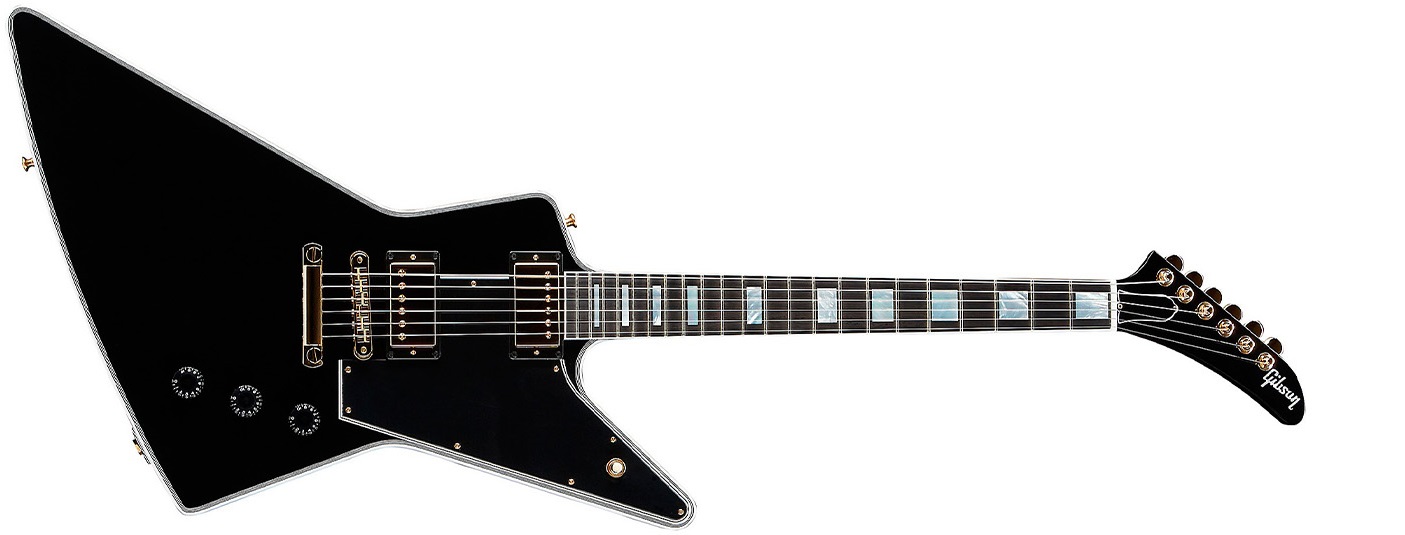
Shining bright with a beautiful black and gold aesthetic reminiscent of the Les Paul Custom, this Gibson Explorer Electric Guitar demands attention.
Finessed for elegance, the guitar combines a glossy and mahogany bound body complimented by a bound headstock – features that instantly captivate.
It’s more than just a pretty face; industrious Gibson Custom 490R/498T humbuckers are brought into play to provide a powerful, rock-and-roll edge.
Guitar Center, known for its pristine Platinum Rooms, has chosen this gem for its Platinum Guitar Collection.
This collection treasures rare, over-the-top pieces from famous builders around the globe, which makes it an exclusive destination for musical mavens.
With its unique features, like a nitrocellulose lacquer finish and vintage-style frets on an ebony fingerboard, this guitar seems to echo these exact sentiments.
Furthermore, the instrument’s precise specs, like the solid mahogany body, medium C neck shape, and Gold tune-o-matic bridge, promise good looks and great performance.
- My Review
From the moment I saw this Gibson Explorer Electric Guitar, it was love at first sight.
Simply put, its black and gold aesthetic is a head-turner.
Radiating an elegance reminiscent of the Les Paul Custom, the glossy, high-quality mahogany body is visually stunning on its own.
As soon as I picked it up, I immediately noticed the weight and balance; it felt right when strapped on.
What struck me was its craftsmanship.
The beautifully executed binding on the body and the headstock, all done with a keen eye for detail, is mind-blowing.
This guitar knows how to dress for the occasion.
Such care is also reflected in its sound, thanks to the Gibson Custom 490R/498T humbuckers.
I experienced firsthand how they brought in that rock-and-roll edge.
The humbuckers are dynamic, producing a loud but clear and balanced tone that’s great for creating heavy music.
I couldn’t help but admire the solid mahogany body and medium C neck shape.
They made the guitar ergonomic and comfortable for hours of play.
Coupled with the Gold tune-o-matic bridge, the instrument exhibited surprisingly stable intonation, taking its performance to the next level.
Being a part of the Guitar Center’s Platinum Guitar Collection carried its quality assurance and exclusive desirability.
The bespoke features, like the nitrocellulose lacquer finish and vintage-style frets on the ebony fingerboard, truly echoed the sentiments expected from such an elite collection.
Certain aspects, though, felt that could be improved upon.
For instance, the neck could be a tad too chunky for those with small hands, but that’s a matter of personal preference.
Nonetheless, this Gibson Explorer Electric Guitar has crafted itself a special place with its design, construction, and tonality blend.
Truly a splendid addition to any guitarist’s repertoire.
- Pros:
- Stunning black and gold aesthetic.
- High-quality Gibson Custom 490R/498T humbuckers.
- Comfortable weight and balance.
- Cons:
- Neck might be too chunky for some.
- Lacks color variety.
- Premium price point.
My final verdict is that the Gibson Explorer Electric Guitar is a remarkable musical instrument with its stunning aesthetics and high-quality components.
While it may not suit everyone’s budget or preferences, its undeniable quality and powerful performance make it an excellent investment and an exciting addition to any guitar collection.
The few shortcomings don’t outweigh the impressive features and the exceptional attention to detail.
Well and truly, Gibson has outdone itself with this model.
Gibson Les Paul Tribute Electric Guitar
High-quality Gibson sound in a lightweight design.
This electric guitar delivers the classic Gibson sound through its 490 humbuckers on an ultramodern, weight-relieved mahogany body. It blends crispness and warmth through its maple neck and rosewood fretboard. Sleek, comfortable design and reliable hardware ensure a stellar playing experience.
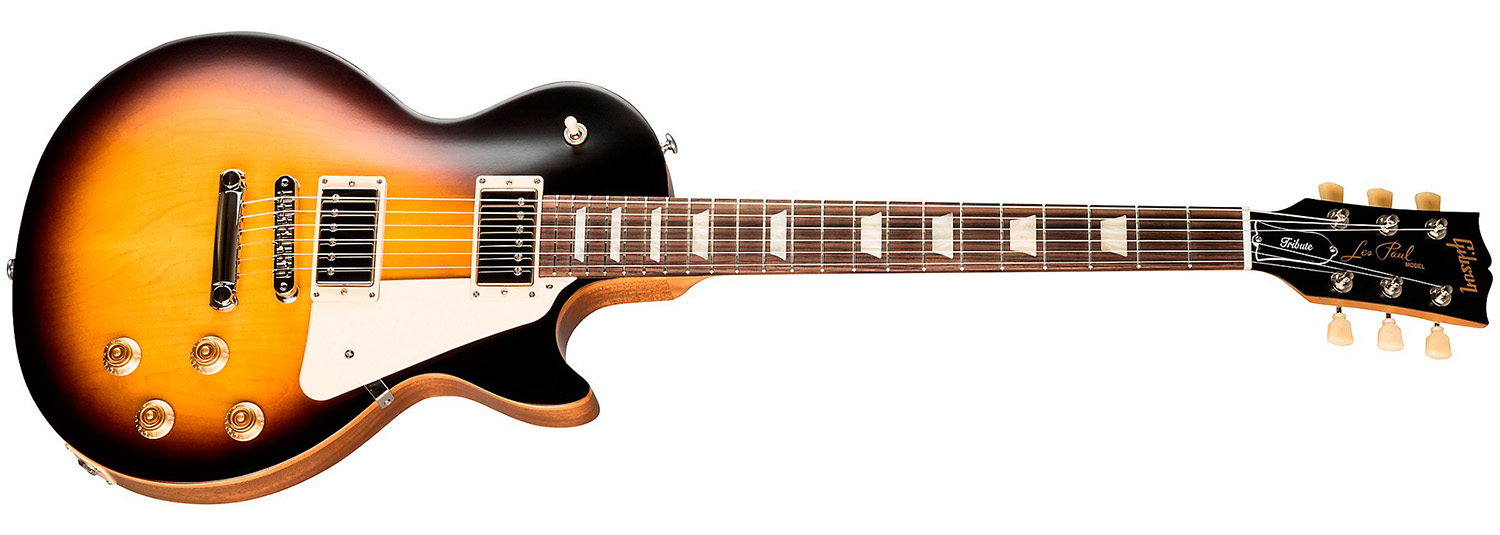
This electric guitar pays homage to the iconic Gibson Les Paul designs, maintaining a traditional aesthetic while incorporating modern elements.
It’s lighter than its past models, thanks to strategically carved-out mahogany in its body, ensuring a comfortable weight without compromising on resonance.
To add a bit of flare, the body features three striking sound holes, enhancing the guitar’s appearance and its overall acoustics.
Its neck combines maple and rosewood, offering a blend of sharpness and warmth, further edging performance with a slim profile and medium jumbo frets.
Its 490 Alnico II humbuckers put forth a powerful vintage PAF tone and impressive sustain.
You can switch between single-coil and humbucking tones with a simple flick for more versatility.
No corners were cut in its hardware, either.
The Nashville Tune-o-matic bridge and stop tailpiece maintain your sound and tuning, and its outfit includes vintage-style tuners.
Moreover, the Plek’d frets ensure a smooth, buzz-free experience along the fretboard.
- My Review
I initially thought of its lightness when I picked up the Gibson Les Paul Tribute Electric Guitar.
The weight-relieved mahogany body was a delight, and the concern that less weight might sacrifice some resonance was unfounded.
This guitar resonated with every chord I hit, producing a bright, clear sound filling the room.
You could easily tell this was a solid wood body, and together with the satin-finished maple top, it produced a sound that was distinctly it’s own.
Examining the guitar further, I was drawn to the three distinct sound holes on the body.
They were not just aesthetically appealing, but they also let the sound breathe, enhancing its overall tonal quality.
Running my hand along the neck, I could feel the blend of the maple wood and rosewood fretboard.
This combination delivered a balanced tone – sharp enough for clear highs yet warm enough for profound bass notes.
As I started strumming, I was impressed by the guitar’s playability.
With its rounded profile and medium jumbo frets, the neck felt incredibly comfortable under my fingertips.
Every fret transition was seamless, with the Plek’d frets providing a buzz-free playing experience.
The 490 Alnico II humbuckers didn’t disappoint when it came to sound.
The sustain was impressive, providing that timeless, vintage PAF tone that just felt like ‘Gibson.’
Swapping between single-coil and humbuckers tones was a welcome feature, allowing tonal versatility.
Lastly, the Nashville Tune-o-matic bridge and vintage-style tuners proved reliable in maintaining sound and tuning.
This was a guitar that seemed intent on delivering consistent performance.
It felt like a package that combined tradition and modernity, ideal for both the Gibson purist and the discerning modern guitarist.
I am captivated by its thoughtful blend of classic design and modern innovations.
- Pros:
- Lightweight, comfortable design.
- Delivers wide tonal range.
- High-quality hardware for reliable performance.
- Cons:
- Satin finish may be prone to nicks.
- Possible rough fret edges.
- Potential issues with pickup switch.
My final verdict is that the Gibson Les Paul Tribute Electric Guitar is a fantastic instrument that expertly fuses traditional and modern elements.
Its lightweight design makes it comfortable for long periods of play, while its distinct tonal range meets the needs of various musical styles.
A few minor issues, like the risk to the satin finish and the potential roughness of fret edges, exist but do not significantly detract from its overall value.
It’s a great fit for both purists of Gibson and modern discerning guitarists.
Gibson Custom ES-335 Electric Guitar
Versatile guitar with rich tone and history.
This electric guitar sets itself apart with its fusion of solid body and hollow body designs, which pair seamlessly with the two ’57 Classic humbucker pickups for diverse, full-bodied tones. It boasts a thin-tapered 1960s neck and rosewood fretboard, and its hardware includes an ABR-1 Tune-O-Matic bridge, Grover tuning heads, and separate volume and tone controls. Drawing on a rich historical legacy, the guitar delivers a blend of mellow tones and solid-body sustain, ideal for jazz, blues, and beyond.
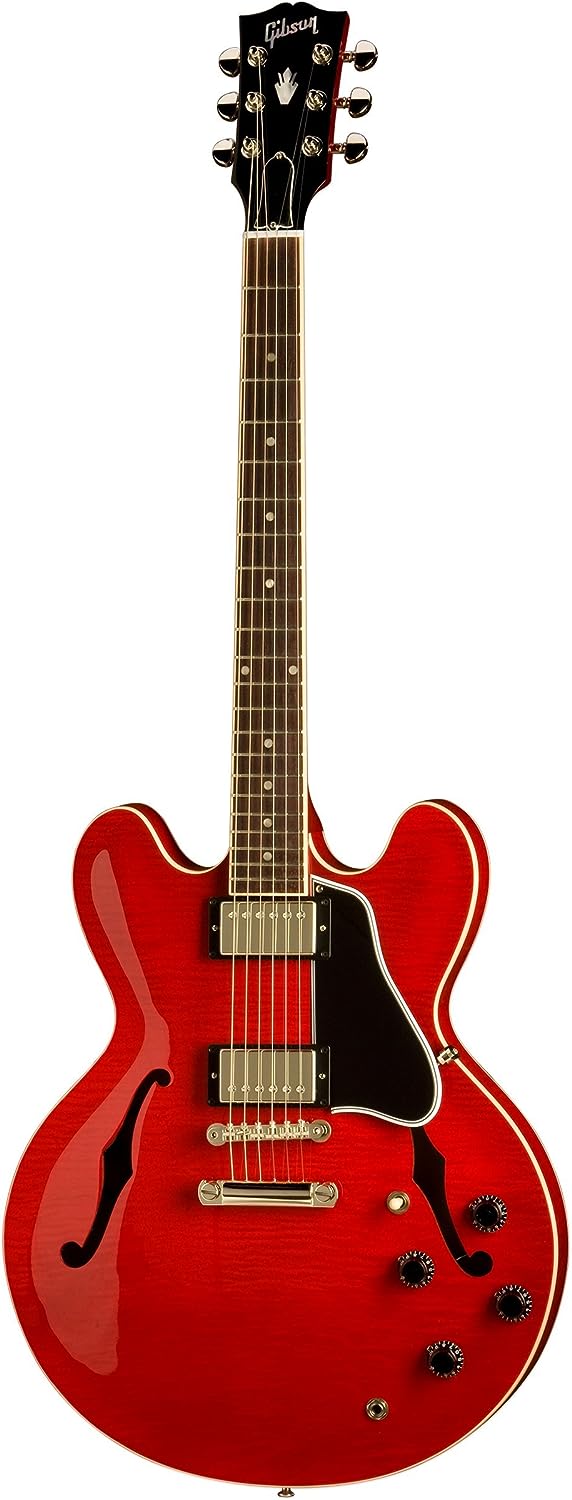
The Gibson Custom ES-335 Dot is essentially a union of solid and hollow body guitar designs.
This special design, along with the two ’57 Classic humbucking pickups, produces a rich, full-bodied tone, making the guitar suitable for all music genres.
It’s a versatile guitar with an aesthetically appealing figured-top cherry finish.
The style of this guitar is further enhanced with its unique double cutaway body and a solid maple block in the center.
The ES-335 Dot offers distinct features such as a thin-tapered 1960s neck and a rosewood fingerboard, nickel-plated hardware with Grover tuning heads and mother-of-pearl inlays.
Unique to this guitar are the separate Volume and Tone controls and a 3-way pickup selector switch.
Gibson Custom Shop has also fitted this guitar with an ABR-1 Tune-O-Matic bridge and stopbar tailpiece.
It’s listed as one of the standout guitars in Gibson’s history and has been the preferred choice for many legendary musicians.
For a fulfilling musical experience, the high-profile use of this guitar has led to its immortalization.
The Gibson ES-335 is offered with several finish options, each of which accentuate the classic dimensions of the guitar.
The hardware of this guitar is nickel, the neck is one-piece mahogany under a 22-fret rosewood fingerboard which enhances the classy vibe of the instrument’s appearance.
The powerful ’57 Classic humbucking pickups, two-volume pots, two-tone pots and a three-way pickup selector switch define the quality of Gibson’s Custom Shop ES-335.
Finally, the attention to detail on the nitrocellulose finish of the guitar not only gives it a stunning look but also ensures the wood ages properly.
- My Review
From my experience, the Gibson Custom ES-335 Dot Electric Guitar stands as an exceptional instrument that perfectly amalgamates the attributes of both solid and hollow body designs.
At the core of its charm, the distinguished figured maple top adds a distinctive allure to the overall presentation, while the gorgeous cherry finish encapsulates its luxurious presence.
The bridge of the guitar is a reliable ABR-1 Tune-O-Matic with a stopbar tailpiece, contributing to the instrument’s unusually fine tuning stability, allowing you to focus more on playing and less on tuning up frequently.
Another distinctive feature is the ’57 Classic humbucking pickups.
This guitar does not only look aesthetically pleasing, but it bears the capabilities to ooze out everything from full-bodied growls to singing sustain.
Indeed, the tones are delightfully versatile, catering effectively to an array of musical styles and genres, proving to be a reliable companion for those impromptu jam sessions or professional musical shows.
The design of the rosewood fingerboard has been tactfully constructed, ensuring comfort and ease of playing for extended sessions.
I also found the mother-of-pearl inlays to add that quintessential, vintage touch to this modern instrument, further complementing its diverse nature.
What makes this product a standout to me are the single-ply bindings on the top and back, curating a balance of individuality and classic Gibson design.
I am also particularly impressed with the neck; a thin-tapered 1960s style neck that ensures comfort and easy access to the upper frets.
As a personal preference, and something which I highly value in any guitar I use, the Gibson Custom ES-335 features a nicely balanced weight – this not only makes it comfortable to play standing up, but it also contributes to the overall tone of the instrument.
The use of nickel-plated hardware does not only add an aesthetic element but I found that it also offers a tone that is bright with a good sustain.
This guitar, with its exclusive attributes, recommends itself as the optimal choice for musicians looking for a versatile, reliable, and visually stunning instrument.
One small drawback that I must mention, though, is the price as it may be a bit steep for some, but I feel that the quality, features and versatility provided by this guitar are more than enough to justify it.
The Gibson Custom ES-335 Dot Electric Guitar amalgamates vintage charm with modern playability, and profoundly showcases Gibson’s commitment to quality and auditory excellence.
- Pros:
- Exceptional versatility in tone.
- Quality built with Figured Maple.
- Dual ’57 Gibson Humbucker pickups.
- Cons:
- Considered pricey by some users.
- May be heavy for some guitarist.
My final verdict is that the Gibson Custom ES-335 Dot Electric Guitar delivers an exceptional blend of the hollow body and solid body guitar designs.
Its versatility in producing everything from a full-bodied growl to a singing sustain using its dual ’57 Gibson humbucker pickups remains unparalleled.
The guitar’s thin-tapered 1960s neck and rosewood fingerboard make it classically stylish and comfortable to play.
Whether you need a guitar for jazz, blues or rock, this all-style music instrument excels in all.
Despite the high price tag, the premium quality and unique features of this guitar make it well worth the investment.
What to Look for When Buying a Gibson Guitar?
When embarking on the quest to purchase a Gibson guitar, many factors come into play due to the brand’s prestigious history and the wide range of available models.
The first thing to consider is the type of music you wish to play, as different models cater to different musical genres.
For instance, the Gibson Les Paul is often the go-to choice for rock enthusiasts, known for its heavy tone and sustain.
At the same time, the Gibson SG offers a lighter, more accessible design with a distinctive tone, making it versatile across genres.
The ES-335, the other hand, is a semi-hollow body guitar that jazz and blues musicians might favor for its warm, mellow sound.
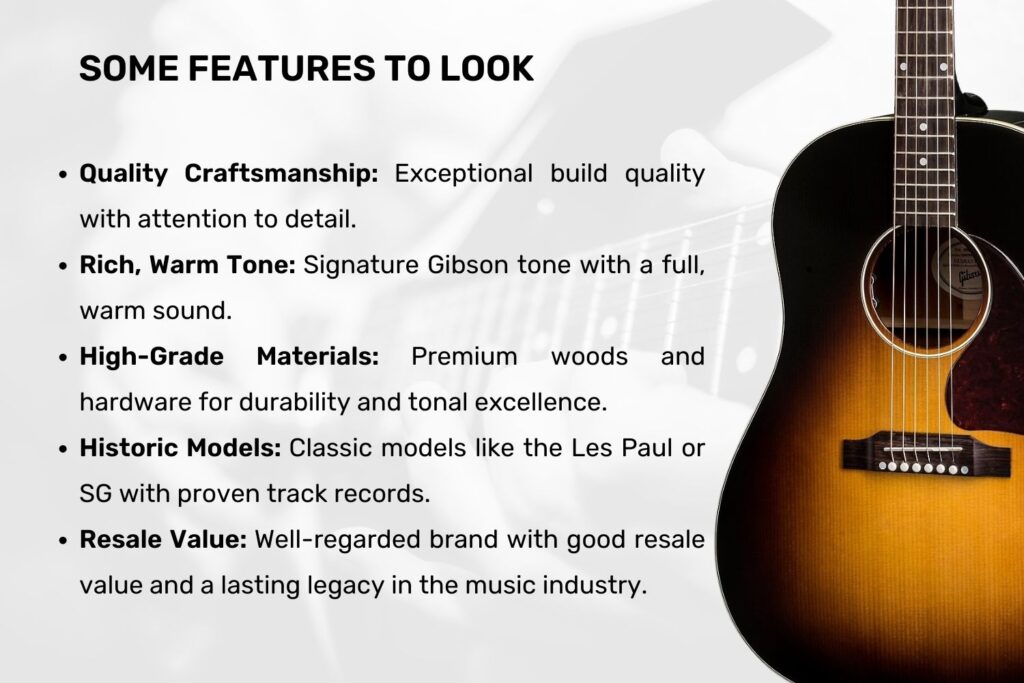
Once you’ve narrowed down on the model that suits your musical taste, delve into the specifics of the guitar.
The wood type affects the guitar’s tone and weight; classic Gibson guitars are known for their mahogany body and neck with a maple top, which provides a balanced, warm tone with a solid low end and a bright top end.
Examining the guitar’s neck is crucial; the neck profile, width, and fingerboard material affect how comfortable the guitar feels.
Gibson offers various neck profiles such as the SlimTaper neck, which is great for players with smaller hands or those who prefer a faster, modern feel, and the Rounded neck profile, which might appeal to players who prefer a chunkier, vintage feel.
The condition of the frets, the action, and the overall setup of the guitar are other critical elements to inspect, as they affect playability.
A well-set-up guitar should have a comfortable action and well-dressed frets and should play in tune up the neck.
Electronics are another vital area; the pickups, the wiring, and the controls all contribute to the guitar’s sound.
Gibson is renowned for its humbucking pickups, like the classic PAFs, which offer a warm, full tone with less noise.
However, they also provide guitars with single-coil P90 pickups for a brighter, punchier tone.
The quality and condition of the hardware, such as the tuners, bridge, and tailpiece, are also important as they affect tuning stability and intonation.
When examining a Gibson guitar, especially a used one, it’s advisable to check for any signs of damage or repairs.
Look for cracks around the headstock, a common area of concern on Gibson guitars.
Furthermore, the guitar’s age and provenance can influence its price and desirability, especially for collectors.
Vintage Gibsons are often sought after for their tone, craftsmanship, and history, though they come with a hefty price tag.
On the other hand, new models offer modern amenities like weight relief, updated electronics, and more ergonomic designs.
If you’re considering a vintage Gibson, it’s wise to research the particular era and model to understand that period’s features and potential issues.
The authenticity of the guitar is paramount.
Verify the serial number with Gibson’s database and examine the logo, headstock design, and other brand-specific features to ensure you’re getting a genuine Gibson.
Buying from reputable dealers or individuals with verifiable references is advisable to avoid counterfeit instruments.
Price is an inevitable consideration.
Gibson guitars are a significant investment, but their resale value remains robust, especially for well-kept vintage models.
Establish a budget, but be prepared for a higher initial investment if you opt for a Gibson.
It’s a purchase that provides a quality instrument and a piece of musical history.
Lastly, but most importantly, playing the guitar before buying is ideal.
The feel, the sound, and the connection you have with the instrument are things specifications on paper can’t fully encapsulate.
If possible, visit a local store or individual seller for hands-on experience with the Gibson guitar you intend to buy.
This journey of purchasing a Gibson guitar is a meticulous but rewarding endeavor, binding you to a lineage of musicians and a legacy of musical innovation.
Through careful consideration and thorough examination of the factors highlighted, you’re on a promising path to owning a musical heritage that resonates with your musical soul.
What Makes Gibson Guitars Stand Out?
The distinctive allure of Gibson guitars stems from a rich tapestry of factors interwoven over a century of masterful guitar crafting, embodying both a timeless tradition and continuous innovation in musical instruments.
The journey begins with the brand’s historical pedigree.
Since its inception in 1894, Gibson has carved a significant niche in the music industry, being associated with legendary musicians who played Gibson guitars to create music that has stood the test of time.
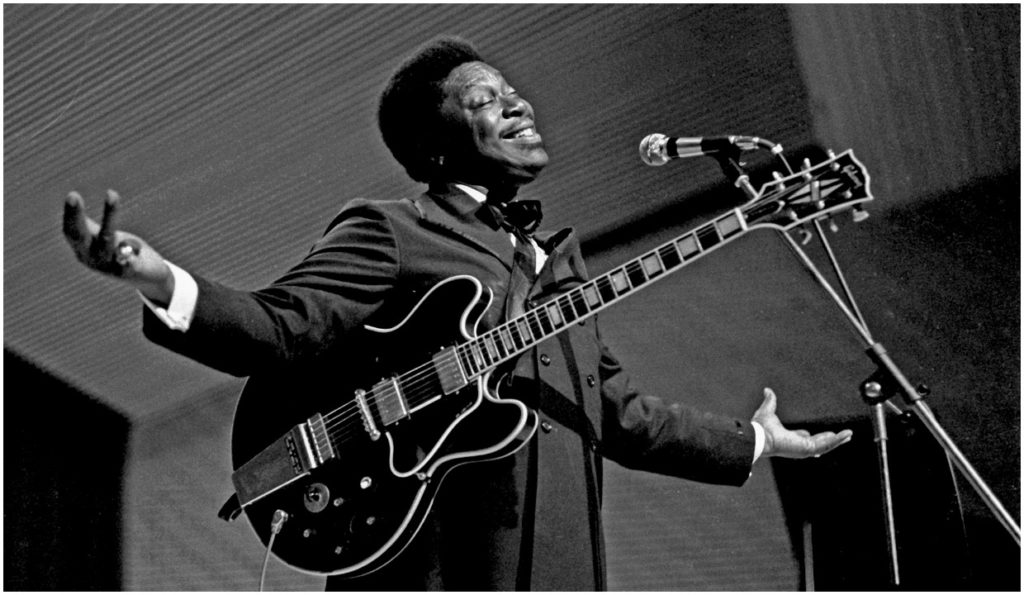
Icons like Les Paul, B.B. King, and Jimmy Page, to name a few, have strummed the strings of Gibson guitars, creating a legacy intertwined with the brand.
A hallmark of Gibson’s enduring appeal is the craftsmanship that goes into each guitar.
The meticulous attention to detail, from the selection of high-quality materials to the skilled hands that shape and assemble the guitars, contributes to the superior quality and durability that Gibson is synonymous with.
The choice of tonewoods, for instance, is a critical aspect; mahogany, maple, and rosewood are often employed for their sonic properties, durability, and aesthetic appeal.
The construction process is an amalgam of traditional handcrafting techniques honed over decades and modern technological advancements ensuring precision and consistency.
The aesthetic allure of Gibson guitars is undeniable.
The classic curves of the Les Paul, the edgy demeanor of the SG, or the elegant form of the ES-335, each model presents a unique visual and tactile experience.
The finishes, often in classic sunbursts or rich, solid colors, enhance the natural beauty of the wood while providing a visual identity to the guitar.
The iconic headstock design, with its open book silhouette and mother-of-pearl logo inlay, is a visual cue that immediately identifies the instrument as a Gibson.
The soul of a Gibson guitar, however, resides in its sound.
The tonal palette offered by Gibson’s range of guitars is as vast as unique.
The warm, rich, and creamy tones of a Les Paul, the sharp, cutting, and clear tones of an SG, or the full, resonant, and mellow tones of an ES-335 cater to a wide spectrum of musical genres and playing styles.
Gibson’s pickups, such as the humbucking pickups, are famed for their ability to reduce noise and hum while providing a powerful, thick tone, a characteristic feature of the Gibson sound.
Equally significant is the playability of Gibson guitars.
The neck profiles, fretboard radius, and ergonomics are crafted to provide a comfortable and intuitive playing experience.
The set-neck construction, a staple in many Gibson models, provides a smooth transition between the neck and body, enhancing playability and sustain.
The quality of the hardware, the tuning stability, and the overall setup contribute to a guitar that invites and inspires playing.
Innovation and adaptability have been at the core of Gibson’s journey.
Over the decades, Gibson has continually evolved to incorporate modern features like coil-tapping, phase switching, and weight-relief chambers, all while retaining the essence of the classic Gibson design.
This blend of tradition and modernity appeals to purists and contemporary musicians, bridging the revered vintage aura and the demands of modern-day guitar playing.
The cultural significance and influence of Gibson guitars extend beyond the music.
They have become emblematic of rock and roll culture, a symbol of musical authenticity, and a conduit through which musicians express their creative ethos.
Gibson guitars have graced countless album covers, concert stages, and music videos, embedding themselves in modern music culture’s visual and auditory lexicon.
In acquiring a Gibson, one is not just purchasing a guitar but a piece of musical heritage, a tool of artistic expression, and a companion in the musical journey.
The total of these factors, the historical legacy, superior craftsmanship, aesthetic appeal, distinctive sound, playability, continuous innovation, and cultural significance sets Gibson guitars apart in a crowded market of musical instruments.
Through storms and sunshine, the Gibson brand has stood resilient, continually striving for excellence and, in the process, crafting guitars that are not just instruments but legends in their own right.
How to Identify a Genuine Gibson Guitar?
Identifying a genuine Gibson guitar can be a meticulous process, given the brand’s prestigious standing in the music world, which unfortunately makes it a target for counterfeiters.
A detailed examination encompassing various aspects of the guitar is crucial to ascertain its authenticity.
From the headstock, genuine Gibson guitars have a distinct ‘open book‘ or ‘tulip’ design, a trademark feature.
The logo on the headstock is another critical indicator; authentic Gibson logos are cleanly inlaid with mother-of-pearl or decal, and the font and positioning are consistent across genuine models.
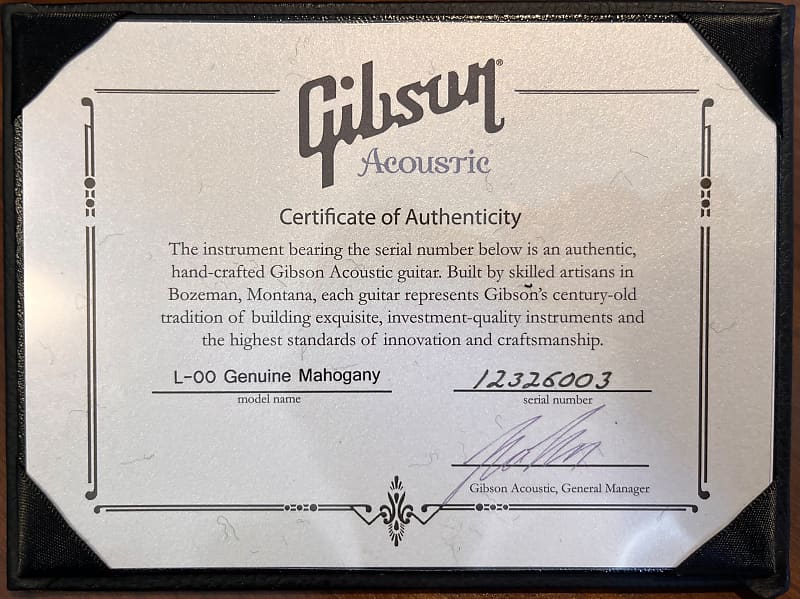
The serial number, usually found on the back of the headstock, is vital information.
It’s advisable to cross-reference this number with Gibson’s official serial number database to verify the guitar’s legitimacy and ascertain its manufacturing date and location.
Moving on to construction, the quality of craftsmanship is a hallmark of genuine Gibson guitars.
The joints, bindings, and overall finish should exhibit high precision and quality.
Gibson guitars typically have a set neck construction instead of a bolt-on neck; the transition between the neck and body should be smooth and well-finished.
The type of wood used is also a sign; Gibson traditionally uses mahogany, maple, and rosewood, which are high-quality tonewoods known for their durability and sound qualities.
The hardware and electronics on a Gibson guitar also indicate its authenticity.
Genuine Gibson guitars have high-quality hardware, including tuners, bridges, and tailpieces that operate smoothly and maintain tuning stability.
The pickups and electronics are crucial areas to inspect.
Gibson’s famous humbucking pickups, like the Burstbucker or ’57 Classic, have a distinctive appearance and are usually branded.
The wiring inside the control cavity should be neat and well-soldered, with quality potentiometers and capacitors.
The accompanying documentation and case can also provide clues.
Authentic Gibson guitars often come with a hardshell case featuring the Gibson logo and a certificate of authenticity or warranty card with matching serial numbers.
However, it’s important to note that documentation and cases can also be forged, so they shouldn’t be the sole basis for verification.
Another advisable step is to compare the guitar with known genuine models, either in person or through reputable online sources.
Discrepancies in design, logo placement, hardware, or anything that seems off could be a red flag.
Furthermore, purchasing from reputable dealers or individuals with verifiable references can significantly reduce the risk of acquiring a counterfeit Gibson.
It’s also advisable to seek the opinion of experienced Gibson guitar owners or a knowledgeable luthier who can help authenticate the guitar.
What Are Some Tips for Maintaining a Gibson Guitar?
Maintaining a Gibson guitar requires a blend of regular care, a keen eye for detail, and an understanding of the instrument’s needs to ensure it stays in prime condition over the years.
The first aspect to consider is the guitar’s environment.
Guitars are sensitive to changes in temperature and humidity.
It’s advisable to store your Gibson in a controlled environment, away from direct sunlight or heat sources, and within a humidity range of 45-55% to prevent warping, cracking, or other forms of damage.
Investing in a good quality hard case is crucial for protecting the guitar when it’s not in use or during transport.
Gibson guitars often come with a hard case, which is tailored to the shape and size of the guitar, providing optimum protection.
Regular cleaning is fundamental to the longevity of a Gibson guitar.
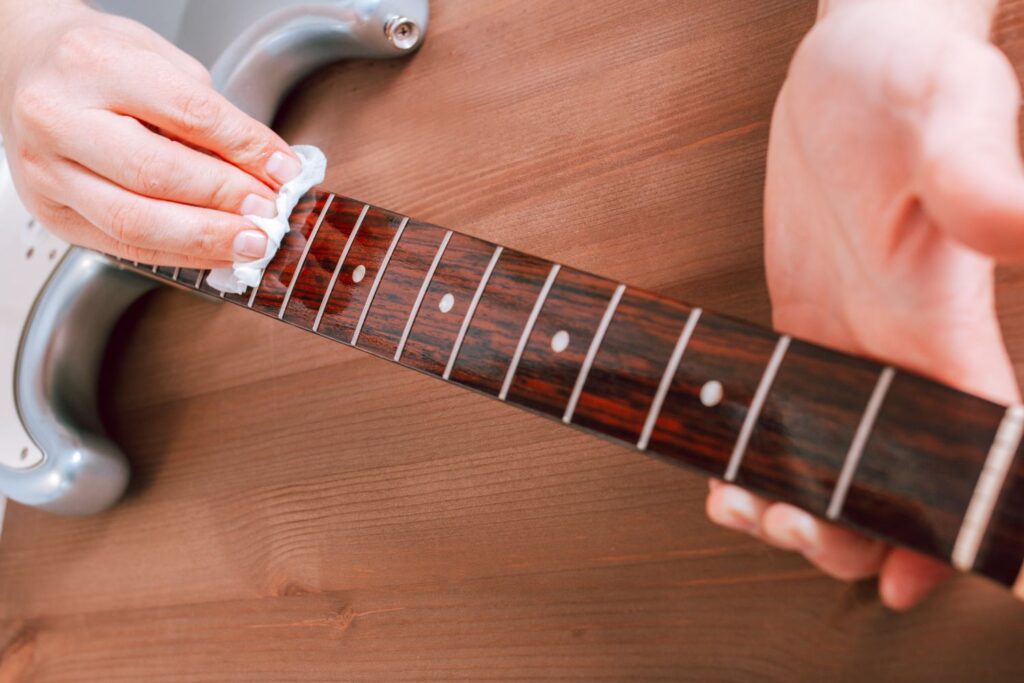
Wiping down the strings, fretboard, and guitar body with a soft, dry cloth after each use can prevent the build-up of sweat, dirt, and oils, which can corrode the strings and dull the finish over time.
It’s advisable to use guitar-specific cleaning products and polishes that are safe for the guitar’s finish.
The fretboard, a crucial part of the guitar, requires particular attention.
Conditioning the fretboard with a guitar-grade lemon oil or fretboard conditioner a few times a year can prevent it from drying out and cracking.
Changing the strings regularly is essential for maintaining a bright tone and the guitar’s overall health.
Old or corroded strings can cause undue stress on the guitar’s neck and damage the frets.
When changing strings, it’s a good practice to clean and condition the fretboard, check the frets for wear, and ensure the nut slots are clean and well-lubricated to prevent binding, which can affect tuning stability.
The setup of a Gibson guitar is a key factor in its playability and sound.
It’s advisable to have the guitar professionally set up by a reputable technician or luthier at least once a year or whenever you notice intonation, action, or fret buzzing issues.
A proper setup will ensure the neck relief, the action is comfortable, and the intonation is accurate, making the guitar a joy to play.
Monitoring the hardware, including the tuners, bridge, and electronics, is also crucial.
Ensure all screws and bolts are tightened but not overtightened and the moving parts are lubricated and functioning smoothly.
The electronics should be checked for any crackling noises when turning the knobs or switching the pickups, which could indicate a need for cleaning or repair.
Furthermore, a Gibson guitar is an investment, and keeping a record of maintenance, repairs, and any modifications, along with preserving the original parts, can help maintain its value over time.
Keeping the guitar insured against potential damage or theft is also advisable.
Lastly, seeking guidance from experienced guitar technicians, luthiers, or fellow musicians and educating oneself about the specific needs and quirks of one’s Gibson guitar model can be invaluable.
A well-maintained Gibson guitar is a reliable and inspiring musical companion and can carry forward the brand’s legacy of quality and musical expression for generations to come.
Regular cleaning, proper storage, timely setups, and attentive care of the hardware and electronics ensure that your Gibson guitar’s hallmark sound and playability remain intact, enriching your musical journey.
How Do Gibson Guitars Compare to Other Brands?
The comparison between Gibson guitars and other brands unveils a rich narrative of unique characteristics, historical significance, and varying approaches to guitar craftsmanship that each brand brings.
Gibson, with its longstanding history dating back to 1894, has become synonymous with high-quality craftsmanship and a distinctive sound that has been embraced by countless musicians over the decades.
The brand’s commitment to maintaining a traditional approach to guitar manufacturing while incorporating modern innovations sets it apart in a crowded market.
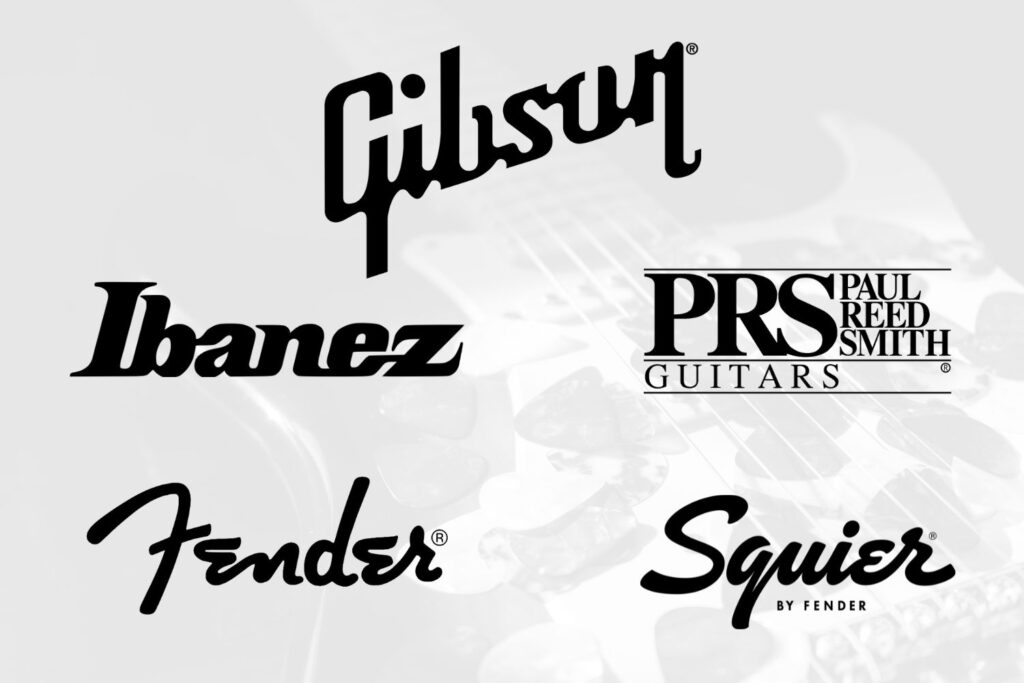
On the other hand, brands like Fender, another titan in the industry, present a different aesthetic and sonic signature, embodying a more modernistic and mass-production approach, especially seen in their iconic Stratocaster and Telecaster models.
Fender guitars are often recognized for their brighter tone and sleek, contoured body designs, which offer a different playability experience compared to the often more robust and classic designs of Gibson.
The tonal differences between Gibson and other brands are often attributed to the choice of materials and construction methods.
Gibson’s preference for tonewoods like mahogany and maple, coupled with set-neck construction, tends to produce a warm, rich, and resonant tone favored in genres like rock, blues, and jazz.
In contrast, with their alder or ash bodies and bolt-on necks, brands like Fender offer a brighter and snappier tone, which has found its place in a wide array of musical genres.
The different pickup designs between these brands further contribute to the tonal distinction, with Gibson’s humbucking pickups known for their thicker, warmer sound and noise-canceling properties, while single-coil pickups often found in Fender guitars are known for their clear, sharp, and bright tones.
Moreover, the playability and feel of Gibson guitars have a unique appeal.
The neck profiles, fretboard radius, and overall ergonomics are crafted to provide a comfortable and intuitive playing experience, which many players find conducive to a certain playing style.
Other brands might have a different approach to the neck shape, fretboard material, and other ergonomic factors, which might appeal to a different demographic of players.
The aesthetic allure of Gibson is also something to reckon with.
The classic designs, high-quality finishes, and iconic models like the Les Paul, SG, and ES-335 have a timeless appeal that many players and collectors find enchanting.
Other brands, too, have their own aesthetic appeal and iconic designs, each with a unique story and place in the history of music.
Regarding pricing, Gibson tends to lean towards the higher end of the price spectrum due to its emphasis on quality, tradition, and the use of premium materials.
Other brands might offer a wider range of price points to cater to different market segments, from beginners to professional musicians.
Innovation and adaptability are at the core of Gibson’s ethos, as seen in their continuous evolution to incorporate modern features like coil-tapping, phase switching, and weight-relief chambers while retaining the essence of the classic Gibson design.
Other brands, too, have their narrative of innovation and adaptation to the evolving needs of musicians.
Furthermore, the cultural significance and influence of Gibson guitars extend beyond the music, becoming emblematic of rock and roll culture, a symbol of musical authenticity.
Similarly, other brands have also embedded themselves in modern music culture, each with a unique legacy and contribution to the musical landscape.
The after-sale value of Gibson guitars often remains high, thanks to the brand’s prestigious standing and the high initial quality of the instruments.
Other brands might have a different depreciation curve, which can be influenced by various factors, including the brand’s reputation, the quality of craftsmanship, and the demand in the used market.
Where Are Gibson Guitars Manufactured?
Gibson guitars are synonymous with a rich heritage of craftsmanship and quality, and much of this prestige is deeply rooted in the locations where these instruments are crafted.
The production of Gibson guitars primarily takes place in the United States, with several facilities dedicated to the meticulous crafting of these iconic instruments.
The mainstay of Gibson’s manufacturing operations has historically been in Nashville, Tennessee.
Many of Gibson’s electric guitars, including the revered Les Paul and SG models, come to life in the Nashville facility.
The process is a blend of time-honored handcrafting techniques intertwined with modern technological advancements to ensure precision, consistency, and the hallmark quality of the Gibson brand.
Furthermore, Gibson’s acoustic guitars are birthed in Bozeman, Montana, a locale synonymous with high-quality acoustic guitar craftsmanship.
The Bozeman facility is a hub of acoustic excellence, where traditional luthiery skills meet modern innovation to create instruments that resonate with the classic Gibson tone and playability.
The selection of tonewoods, the hand-scalloped bracing, and the attention to detail in every aspect of the construction process in Bozeman contribute to the superior tonal quality and aesthetic appeal of Gibson acoustic guitars.
Not far from Nashville, in Memphis, Tennessee, Gibson had another facility dedicated to creating its semi-hollow and hollow-body electric guitars.
The Memphis facility was known for producing models like the ES-335 and was revered for maintaining a tradition of handcrafting that lent a unique character to each instrument.
However, in recent years, the operations from the Memphis facility were consolidated into the Nashville plant to streamline the production process while maintaining high standards of quality and craftsmanship.
Moreover, Gibson has also explored international manufacturing avenues.
The Epiphone brand, which Gibson owns, has its guitars manufactured in factories in countries like China and Indonesia.
While Epiphone operates under the Gibson umbrella, it caters to a different market segment, providing more affordable options for players while maintaining quality and design influence from its parent company.

